Marc Tyler Nobleman's Blog, page 6
April 12, 2023
An eventful six weeks: London, ghost town, Survivor Island, Angkor Wat
After a slow fall (only one speaking engagement), I made up for it with a whirlwind six weeks (home for only three single days in between trips):
2/17-24 London 2/27-3/3 Las Vegas3/6-8 Connecticut (not pictured, grew up there)3/11-22 Taiwan3/22-3/25 Malaysia (including Survivor Island)3/26-4/1 Cambodia (including Angkor Wat)
This included presentations at 18 schools and one conference.
Beyond that, I was so fortunate to see so much wonder:
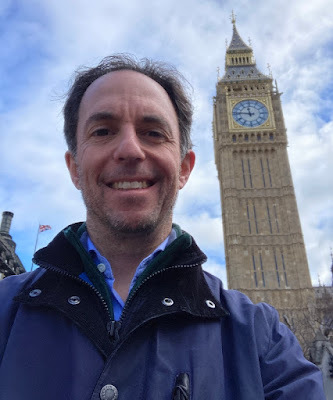 Big Ben, London
Big Ben, London
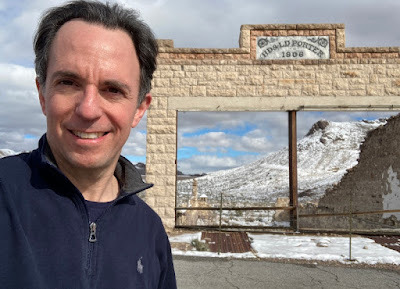 Rhyolite ghost town, two hours from Las Vegason the edge of Death Valley
Rhyolite ghost town, two hours from Las Vegason the edge of Death Valley
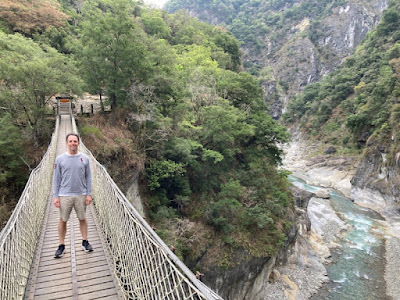 Taroko Gorge, Taiwan(wake-up for train: 5:15 am)
Taroko Gorge, Taiwan(wake-up for train: 5:15 am)
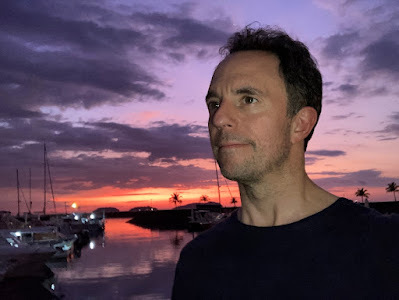 Kota Kinabalu, Malaysia (coast of the South China Sea)
Kota Kinabalu, Malaysia (coast of the South China Sea)
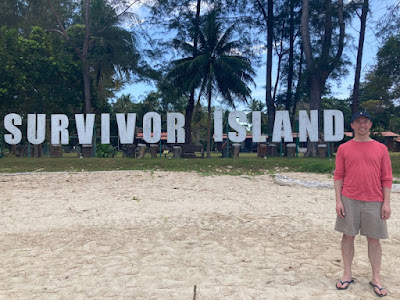 Pulau Tiga (AKA "Survivor Island"),Borneo, Malaysia(wakeup for planning: 6 am)
Pulau Tiga (AKA "Survivor Island"),Borneo, Malaysia(wakeup for planning: 6 am)
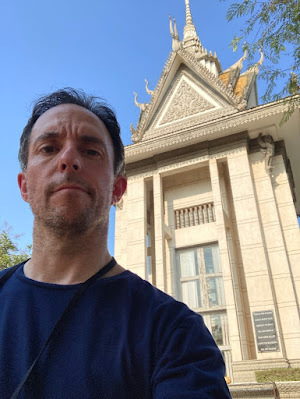 Killing Fields, Phnom Penh, Cambodia(wakeup for flight: 2:50 am)
Killing Fields, Phnom Penh, Cambodia(wakeup for flight: 2:50 am)
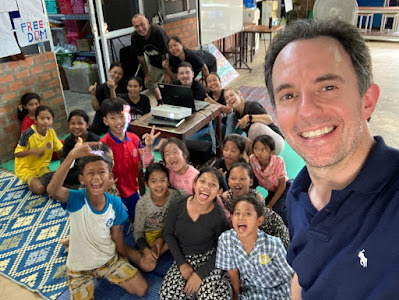 Siem Reap, Cambodia
Siem Reap, Cambodia
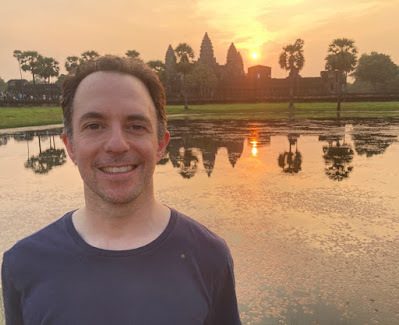 Angkor Wat, Cambodia
Angkor Wat, Cambodia
(wakeup for sunrise: 4:30 am)
Side note: most of my shirts/tops are blue.
2/17-24 London 2/27-3/3 Las Vegas3/6-8 Connecticut (not pictured, grew up there)3/11-22 Taiwan3/22-3/25 Malaysia (including Survivor Island)3/26-4/1 Cambodia (including Angkor Wat)
This included presentations at 18 schools and one conference.
Beyond that, I was so fortunate to see so much wonder:
 Big Ben, London
Big Ben, London Rhyolite ghost town, two hours from Las Vegason the edge of Death Valley
Rhyolite ghost town, two hours from Las Vegason the edge of Death Valley Taroko Gorge, Taiwan(wake-up for train: 5:15 am)
Taroko Gorge, Taiwan(wake-up for train: 5:15 am) Kota Kinabalu, Malaysia (coast of the South China Sea)
Kota Kinabalu, Malaysia (coast of the South China Sea) Pulau Tiga (AKA "Survivor Island"),Borneo, Malaysia(wakeup for planning: 6 am)
Pulau Tiga (AKA "Survivor Island"),Borneo, Malaysia(wakeup for planning: 6 am) Killing Fields, Phnom Penh, Cambodia(wakeup for flight: 2:50 am)
Killing Fields, Phnom Penh, Cambodia(wakeup for flight: 2:50 am) Siem Reap, Cambodia
Siem Reap, Cambodia Angkor Wat, Cambodia
Angkor Wat, Cambodia(wakeup for sunrise: 4:30 am)
Side note: most of my shirts/tops are blue.
Published on April 12, 2023 04:00
April 11, 2023
Angkor Wat and other historic Cambodian temples
Part of a series: Asia, March 2023:
Taiwan—Taipei American School Malaysia—EARCOS conference (Kota Kinabalu)Malaysia—Survivor Island (Borneo)Cambodia—schools and history in Phnom PenhCambodia—Siem ReapCambodia—Angkor Wat/other temples
After a heartening visit with the kids of Heartprint, I rested up for a big day at the biggest religious site in the world.
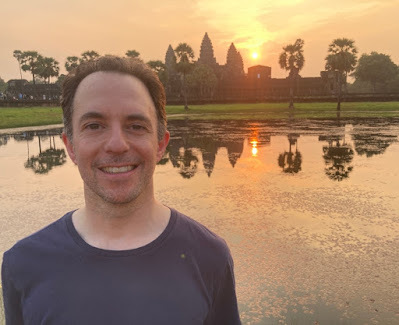
Angkor Wat, by the numbers:
(Not numbers you can find elsewhere—years built, size in acres, amount of structures, year abandoned, etc. Rather numbers of my personal experience.)
time I woke: 4:30 am for a 5 am departuretime we arrived at Angkor Wat: 5:15 amtime we left: 12:45 pmnumber of photos I took: 752number of photos I kept: 261number of steps: many but unsure of the precise amount; I didn’t check that day and now that I’m home, the app recalibrated to my local time zone, which split the steps between two days
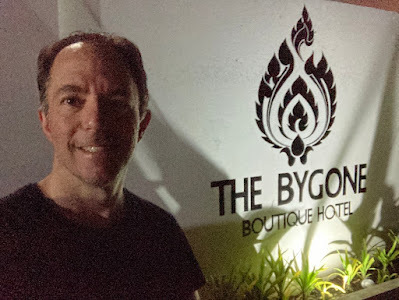 leaving my hotel at 5 am
leaving my hotel at 5 am
Angkor Wat is not a single building but rather a temple complex. Built in the 12th century, it is the best preserved of the numerous sites from that era in the area, which includes dozens of other temples.
The site was originally devoted to Hindu worship. Less than 100 years after its construction, it transitioned to Buddhist. Today it is regularly referred to as “Hindu-Buddhist.”
Nearby sites I visited:
Angkor Thom, a fortressed royal city also built in the 12th century; home to the Bayon temple (known for its many faces) and the Terrace of the ElephantsTa Prohm Temple (sometimes called the jungle temple and featured in the 2001 film Lara Croft: Tomb Raider)
As noted in my last post, my driver was Peng. My tour guide for all this stunning history was the supremely knowledge Huot. My mood was heightened.
Hard not to be:
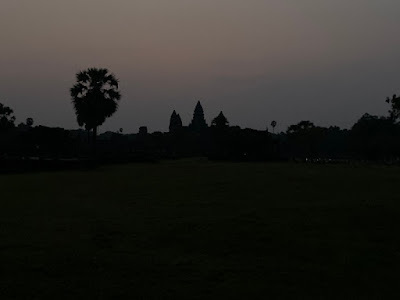 first glimpse of Angkor Wat main complex, 5:36 am
first glimpse of Angkor Wat main complex, 5:36 am
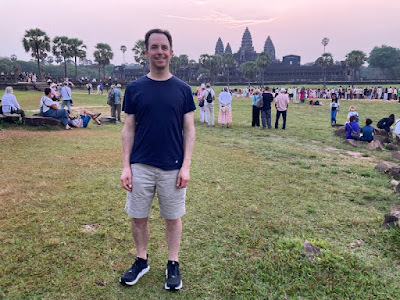 6:02 am
6:02 am
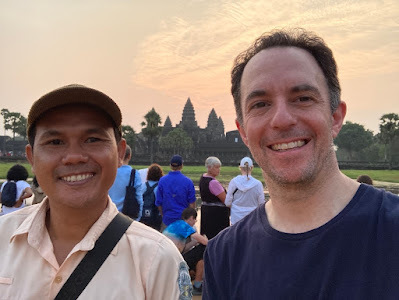 Hout, 6:20 am
Hout, 6:20 am
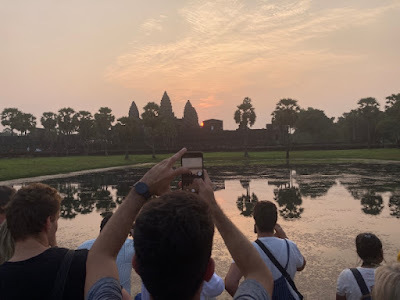 first glimpse of sun, 6:24 am
first glimpse of sun, 6:24 am
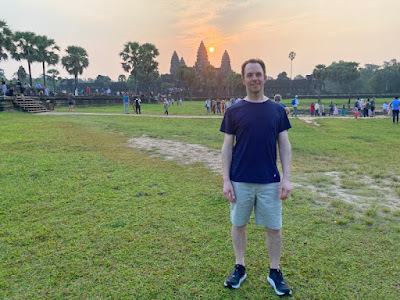
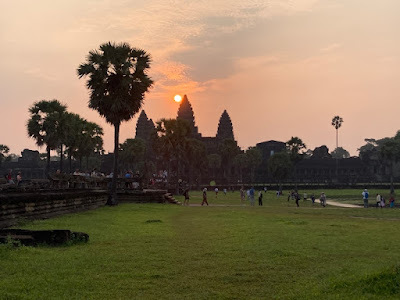
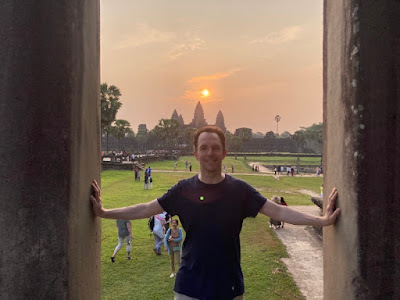 view from one of two libraries (one for men, one for women) along path to main complex
view from one of two libraries (one for men, one for women) along path to main complex
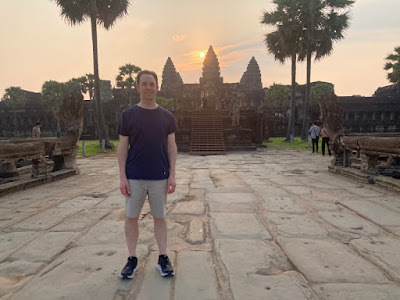
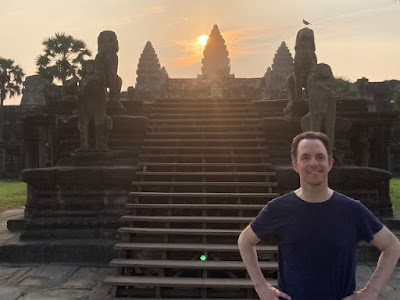 7:02 am
7:02 am
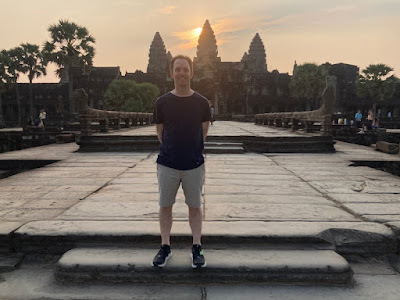
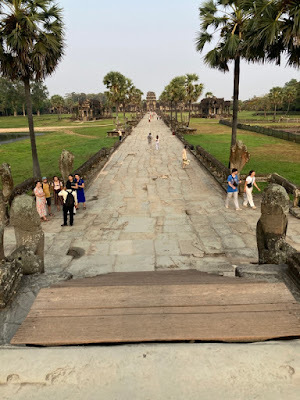 view of entance to main complex from stairs of main complex
view of entance to main complex from stairs of main complex
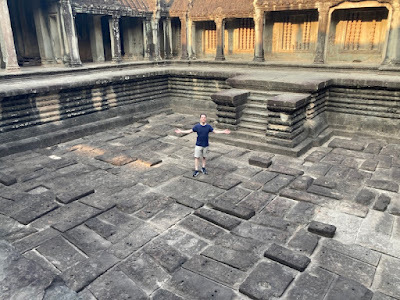 this was one of four pools (representing water, air, fire, earth)
this was one of four pools (representing water, air, fire, earth)
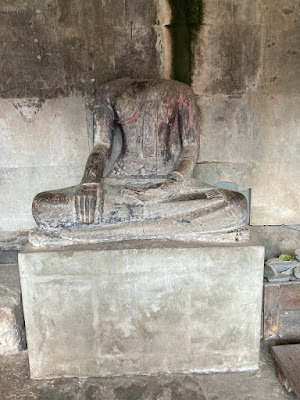 one of many headless Buddhas(heads were stolen after the fall of Pol Pot)
one of many headless Buddhas(heads were stolen after the fall of Pol Pot)
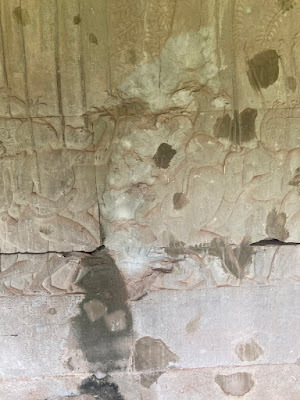 bullet holes from the 1970s conflict with Vietnam
bullet holes from the 1970s conflict with Vietnam
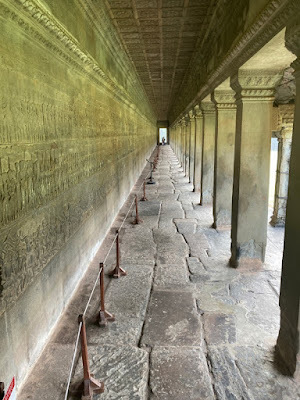
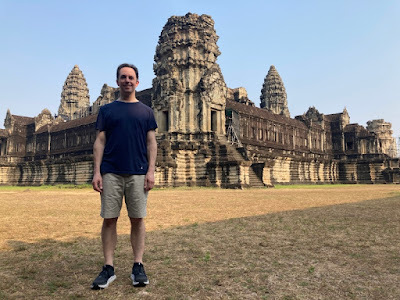
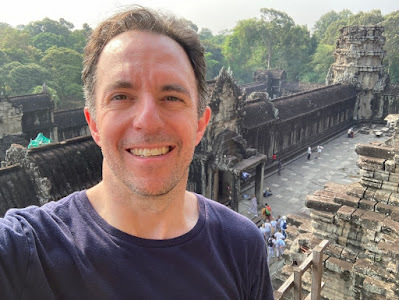 view from level 3 (highest level of Angkor Wat)
view from level 3 (highest level of Angkor Wat)
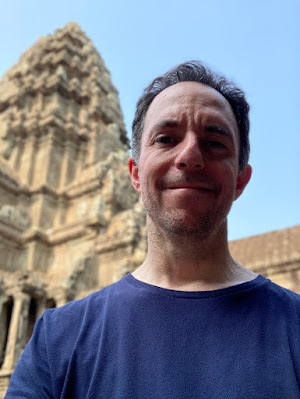
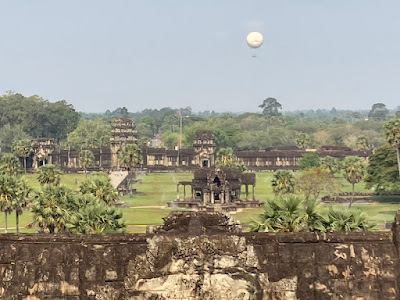 balloon to give tourists a unique view (taken from level 3 of Angkor Wat)
balloon to give tourists a unique view (taken from level 3 of Angkor Wat)
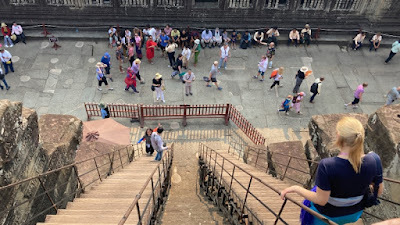 view from level 3 to level 2
view from level 3 to level 2
walking down from level 3 to level 2
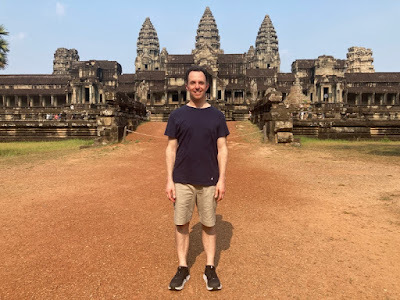 rear of main complex, 8:53 am(meaning I spent more than three hours there)
rear of main complex, 8:53 am(meaning I spent more than three hours there)
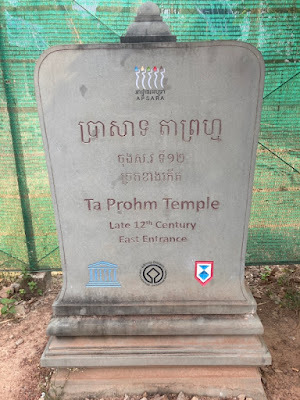 Ta Prohm Temple
Ta Prohm Temple
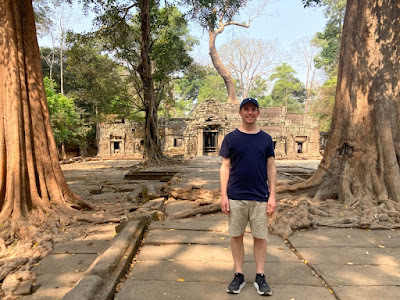
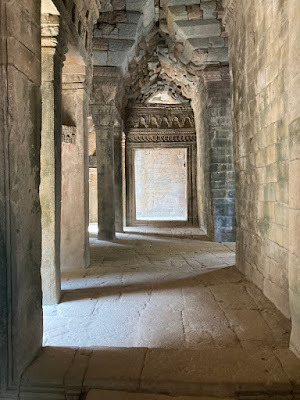
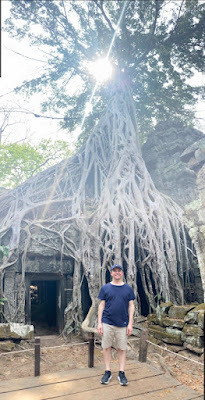
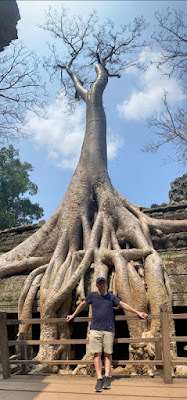
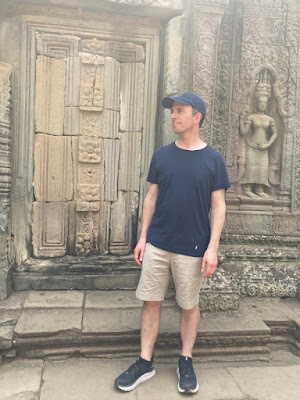
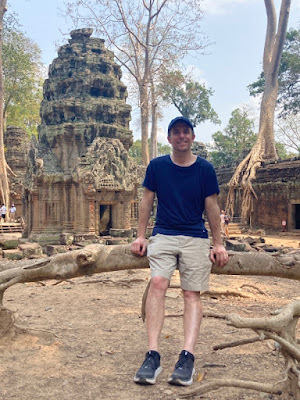
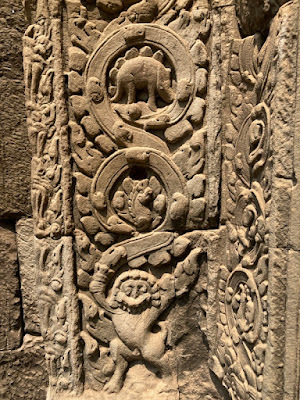 Look closely...
Look closely...
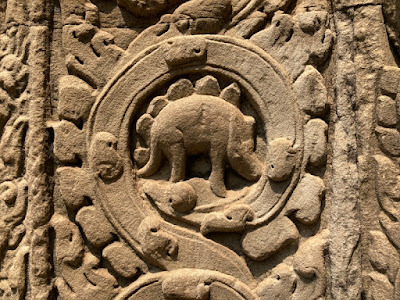 Yup. A stegosaurus. A DINOSAUR. Depicted in a temple builtin the 12th century. Evidence that humans and dinosaurs co-existed?
Yup. A stegosaurus. A DINOSAUR. Depicted in a temple builtin the 12th century. Evidence that humans and dinosaurs co-existed?
Conjecture by people of the era about an animal unearthed bones could have come from? A cow or another animal with palm leaves behind it? Myth? Hoax?
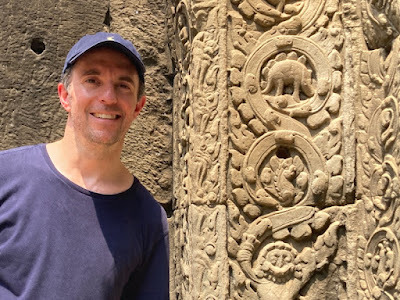
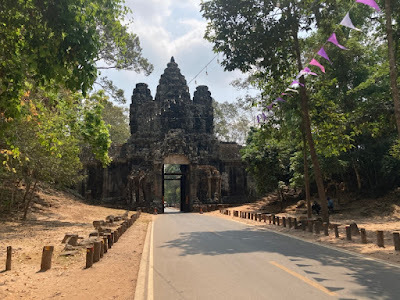
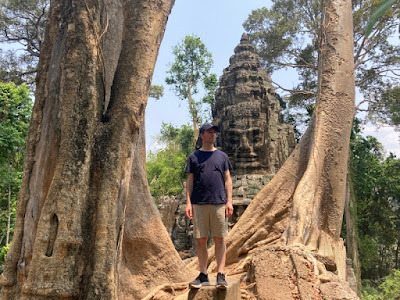 I think this is South Gate, one of five gates that stood around Angkor Thom.
I think this is South Gate, one of five gates that stood around Angkor Thom.
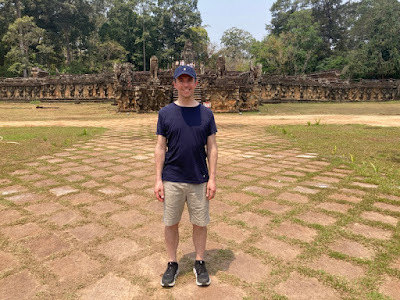 Terrace of the Elephants;I was standing in I was told what was once an arena for variouscompetitions and festivities
Terrace of the Elephants;I was standing in I was told what was once an arena for variouscompetitions and festivities
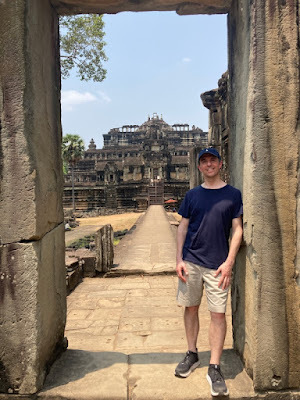
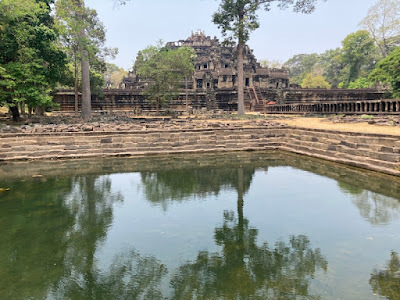 a pool that was apparently used for swimming
a pool that was apparently used for swimming
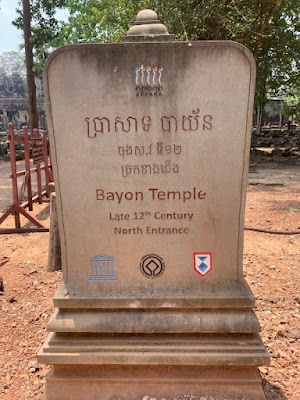 Bayon Temple
Bayon Temple
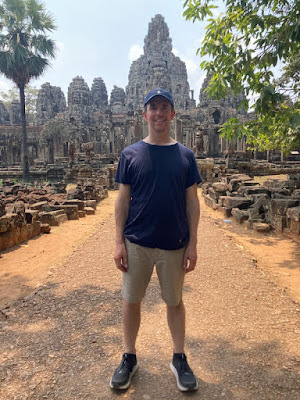
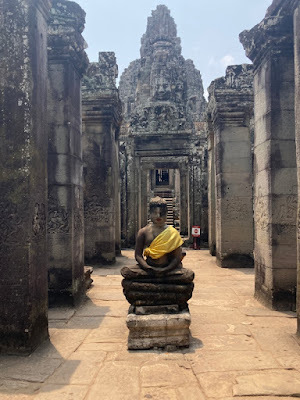
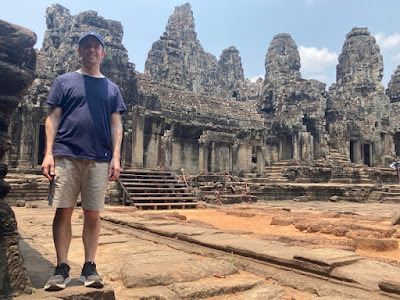
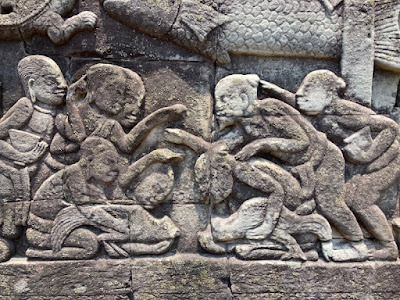 Khmer (long ears) vs. Chinese (short ears) cockfighting
Khmer (long ears) vs. Chinese (short ears) cockfighting
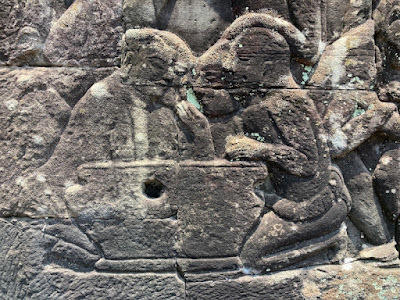 arm wrestling!
arm wrestling!
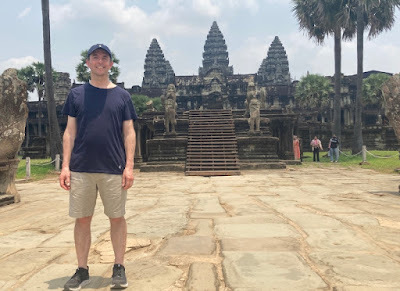 back at Angkor Wat for different lighting; 12:35 pm
back at Angkor Wat for different lighting; 12:35 pm
Angkor Wat comes into view from main entrance
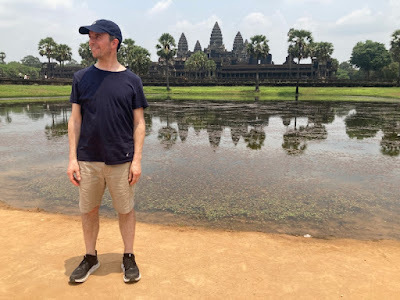
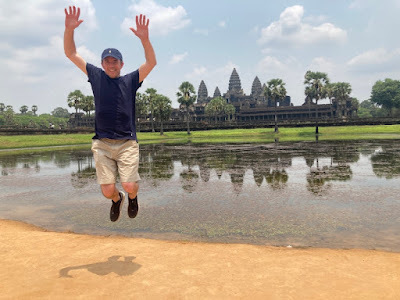 Huot suggested I do this.
Huot suggested I do this.
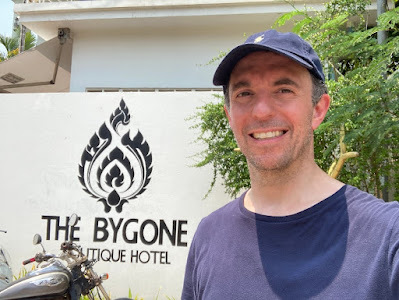 back at the hotel; 1:17 pm
back at the hotel; 1:17 pm
Taiwan—Taipei American School Malaysia—EARCOS conference (Kota Kinabalu)Malaysia—Survivor Island (Borneo)Cambodia—schools and history in Phnom PenhCambodia—Siem ReapCambodia—Angkor Wat/other temples
After a heartening visit with the kids of Heartprint, I rested up for a big day at the biggest religious site in the world.

Angkor Wat, by the numbers:
(Not numbers you can find elsewhere—years built, size in acres, amount of structures, year abandoned, etc. Rather numbers of my personal experience.)
time I woke: 4:30 am for a 5 am departuretime we arrived at Angkor Wat: 5:15 amtime we left: 12:45 pmnumber of photos I took: 752number of photos I kept: 261number of steps: many but unsure of the precise amount; I didn’t check that day and now that I’m home, the app recalibrated to my local time zone, which split the steps between two days
 leaving my hotel at 5 am
leaving my hotel at 5 amAngkor Wat is not a single building but rather a temple complex. Built in the 12th century, it is the best preserved of the numerous sites from that era in the area, which includes dozens of other temples.
The site was originally devoted to Hindu worship. Less than 100 years after its construction, it transitioned to Buddhist. Today it is regularly referred to as “Hindu-Buddhist.”
Nearby sites I visited:
Angkor Thom, a fortressed royal city also built in the 12th century; home to the Bayon temple (known for its many faces) and the Terrace of the ElephantsTa Prohm Temple (sometimes called the jungle temple and featured in the 2001 film Lara Croft: Tomb Raider)
As noted in my last post, my driver was Peng. My tour guide for all this stunning history was the supremely knowledge Huot. My mood was heightened.
Hard not to be:
 first glimpse of Angkor Wat main complex, 5:36 am
first glimpse of Angkor Wat main complex, 5:36 am 6:02 am
6:02 am Hout, 6:20 am
Hout, 6:20 am first glimpse of sun, 6:24 am
first glimpse of sun, 6:24 am

 view from one of two libraries (one for men, one for women) along path to main complex
view from one of two libraries (one for men, one for women) along path to main complex
 7:02 am
7:02 am
 view of entance to main complex from stairs of main complex
view of entance to main complex from stairs of main complex this was one of four pools (representing water, air, fire, earth)
this was one of four pools (representing water, air, fire, earth) one of many headless Buddhas(heads were stolen after the fall of Pol Pot)
one of many headless Buddhas(heads were stolen after the fall of Pol Pot) bullet holes from the 1970s conflict with Vietnam
bullet holes from the 1970s conflict with Vietnam

 view from level 3 (highest level of Angkor Wat)
view from level 3 (highest level of Angkor Wat)
 balloon to give tourists a unique view (taken from level 3 of Angkor Wat)
balloon to give tourists a unique view (taken from level 3 of Angkor Wat) view from level 3 to level 2
view from level 3 to level 2walking down from level 3 to level 2
 rear of main complex, 8:53 am(meaning I spent more than three hours there)
rear of main complex, 8:53 am(meaning I spent more than three hours there) Ta Prohm Temple
Ta Prohm Temple





 Look closely...
Look closely... Yup. A stegosaurus. A DINOSAUR. Depicted in a temple builtin the 12th century. Evidence that humans and dinosaurs co-existed?
Yup. A stegosaurus. A DINOSAUR. Depicted in a temple builtin the 12th century. Evidence that humans and dinosaurs co-existed?Conjecture by people of the era about an animal unearthed bones could have come from? A cow or another animal with palm leaves behind it? Myth? Hoax?


 I think this is South Gate, one of five gates that stood around Angkor Thom.
I think this is South Gate, one of five gates that stood around Angkor Thom. Terrace of the Elephants;I was standing in I was told what was once an arena for variouscompetitions and festivities
Terrace of the Elephants;I was standing in I was told what was once an arena for variouscompetitions and festivities
 a pool that was apparently used for swimming
a pool that was apparently used for swimming Bayon Temple
Bayon Temple


 Khmer (long ears) vs. Chinese (short ears) cockfighting
Khmer (long ears) vs. Chinese (short ears) cockfighting arm wrestling!
arm wrestling! back at Angkor Wat for different lighting; 12:35 pm
back at Angkor Wat for different lighting; 12:35 pmAngkor Wat comes into view from main entrance

 Huot suggested I do this.
Huot suggested I do this. back at the hotel; 1:17 pm
back at the hotel; 1:17 pm
Published on April 11, 2023 04:00
April 10, 2023
Siem Reap, Cambodia
Part of a series: Asia, March 2023:
Taiwan—Taipei American School Malaysia—EARCOS conference (Kota Kinabalu)Malaysia—Survivor Island (Borneo)Cambodia—schools and history in Phnom PenhCambodia—Siem ReapCambodia—Angkor Wat/other temples
On 3/30/23, I flew an hour from Phnom Penh to Siem Reap, the final stop of my three-week trip to Asia. I had two partial days and one full day there.
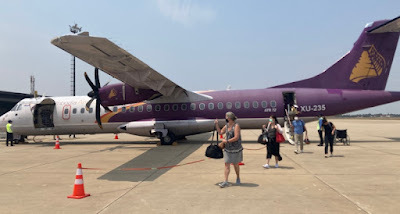
The city is well known for its proximity to Angkor Wat and other truly breathtaking temples, many if not most built at least 1,000 years ago.
The centerpiece of my first half-day was a heartwarming visit with kids who participate in a charity/NGO called Heartprint, founded and run by a superhumanly big-hearted Australian couple, Wendy and Garry O’Brien.
Parents of two adult kids of their own, the O’Briens packed up their lives and souls and relocated permanently to Cambodia about 10 years ago, dedicated to helping those with (much) less.
Their efforts are exhaustive, though they downplay them: everything from providing a community center for kids to building new homes ($1,800 each) for families.
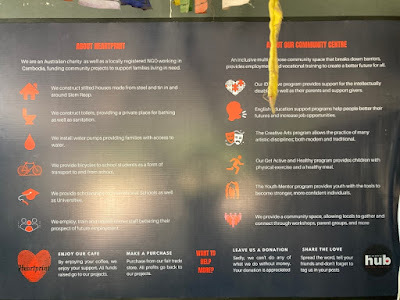
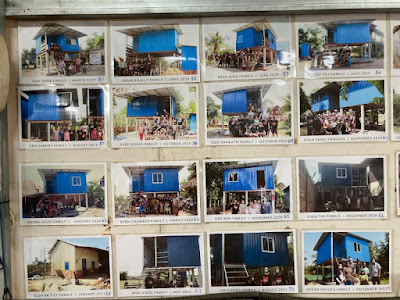 Naturally, they document each house; here is a partial gallery.
Naturally, they document each house; here is a partial gallery.
To help fund their noble endeavors, they also built and run a new boutique hotel liltingly called The Bygone, staffed by locals. I stayed there, and it’s more than charming.
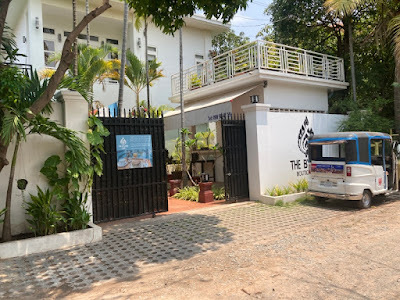
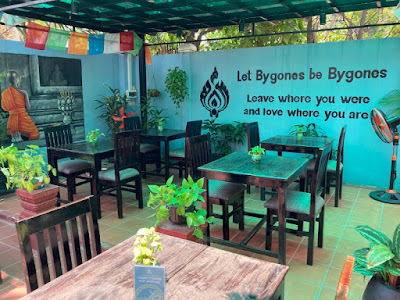
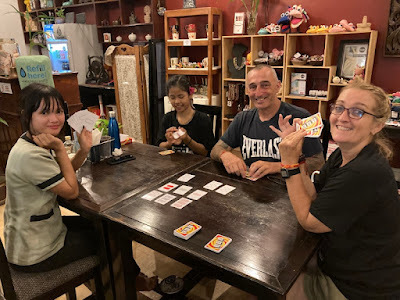 playing Set, a game I have loved since college,with the O’Briens and two lovely staffers;the game was in the activities trunk of the lobbybut none of them had played before
playing Set, a game I have loved since college,with the O’Briens and two lovely staffers;the game was in the activities trunk of the lobbybut none of them had played before
Bonus: they make a mean pad thai and, like my hotel in Phnom Penh, also had homemade banana bread! I kept getting spoiled on the other side of the world.
My roommate: a small gecko with a big voice. Which he used at random intervals throughout the night.
My Heartprint visit comprised a short talk about Superman and Batman (though Cambodians seem more partial to Spider-Man), a read-aloud of The Runaway Pea by Kjartan Poskitt, illustrated by Alex Willmore, and a drawing activity where we all created a new superhero. The kids were so sweet and attentive, whatever their level of English.
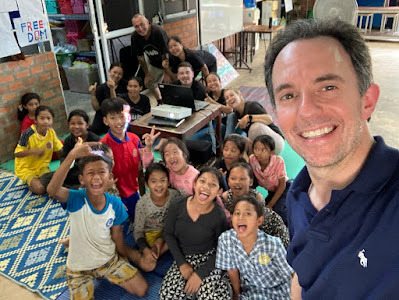
The cozy library at Heartprint:
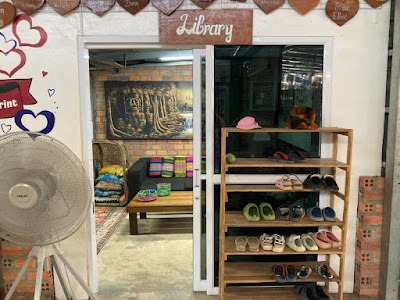
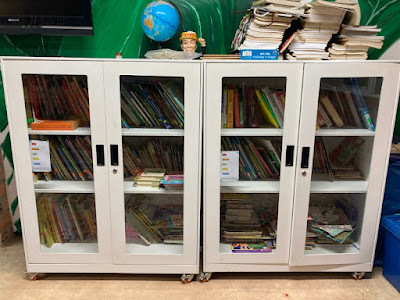
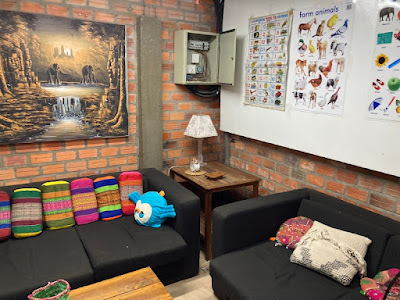
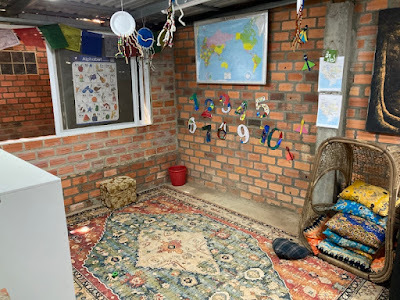
A colleague of the O’Briens, Peng, was my trusty chauffeur throughout the trip, including my tour of the temples. He seemed to have a permanent smile.
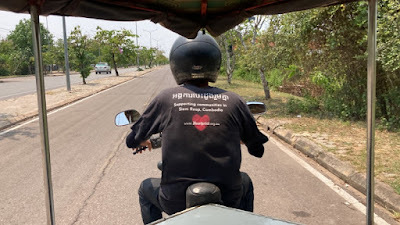 heading from the airport to the hotel
heading from the airport to the hotel
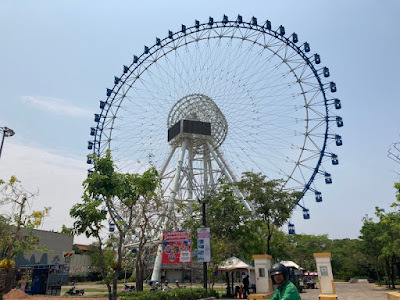
He also seems to be a local celebrity, with a mononym and a multifaceted business (complete with pamphlet)—including a crocodile farm.
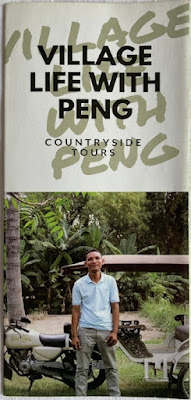
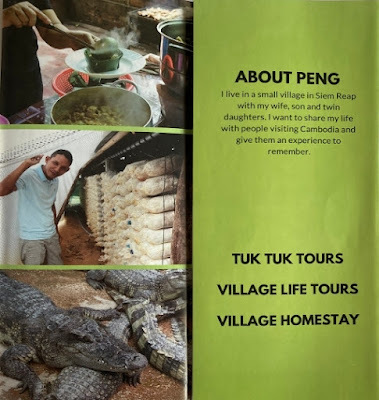
The third and last day was reserved for catching up on work in the hotel.
The full day in between was filled with awe—touring Angkor Wat and other Hindu-Buddhist temples of the region. Naturally, something that majestic demands its own post.
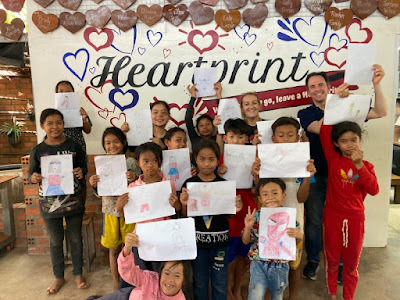 our superhero designs
our superhero designs
Taiwan—Taipei American School Malaysia—EARCOS conference (Kota Kinabalu)Malaysia—Survivor Island (Borneo)Cambodia—schools and history in Phnom PenhCambodia—Siem ReapCambodia—Angkor Wat/other temples
On 3/30/23, I flew an hour from Phnom Penh to Siem Reap, the final stop of my three-week trip to Asia. I had two partial days and one full day there.

The city is well known for its proximity to Angkor Wat and other truly breathtaking temples, many if not most built at least 1,000 years ago.
The centerpiece of my first half-day was a heartwarming visit with kids who participate in a charity/NGO called Heartprint, founded and run by a superhumanly big-hearted Australian couple, Wendy and Garry O’Brien.
Parents of two adult kids of their own, the O’Briens packed up their lives and souls and relocated permanently to Cambodia about 10 years ago, dedicated to helping those with (much) less.
Their efforts are exhaustive, though they downplay them: everything from providing a community center for kids to building new homes ($1,800 each) for families.

 Naturally, they document each house; here is a partial gallery.
Naturally, they document each house; here is a partial gallery.To help fund their noble endeavors, they also built and run a new boutique hotel liltingly called The Bygone, staffed by locals. I stayed there, and it’s more than charming.


 playing Set, a game I have loved since college,with the O’Briens and two lovely staffers;the game was in the activities trunk of the lobbybut none of them had played before
playing Set, a game I have loved since college,with the O’Briens and two lovely staffers;the game was in the activities trunk of the lobbybut none of them had played beforeBonus: they make a mean pad thai and, like my hotel in Phnom Penh, also had homemade banana bread! I kept getting spoiled on the other side of the world.
My roommate: a small gecko with a big voice. Which he used at random intervals throughout the night.
My Heartprint visit comprised a short talk about Superman and Batman (though Cambodians seem more partial to Spider-Man), a read-aloud of The Runaway Pea by Kjartan Poskitt, illustrated by Alex Willmore, and a drawing activity where we all created a new superhero. The kids were so sweet and attentive, whatever their level of English.

The cozy library at Heartprint:




A colleague of the O’Briens, Peng, was my trusty chauffeur throughout the trip, including my tour of the temples. He seemed to have a permanent smile.
 heading from the airport to the hotel
heading from the airport to the hotel
He also seems to be a local celebrity, with a mononym and a multifaceted business (complete with pamphlet)—including a crocodile farm.


The third and last day was reserved for catching up on work in the hotel.
The full day in between was filled with awe—touring Angkor Wat and other Hindu-Buddhist temples of the region. Naturally, something that majestic demands its own post.
 our superhero designs
our superhero designs
Published on April 10, 2023 04:00
April 9, 2023
Phnom Penh, Cambodia, including the Killing Fields
Part of a series: Asia, March 2023:
Taiwan—Taipei American School Malaysia—EARCOS conference (Kota Kinabalu)Malaysia—Survivor Island (Borneo)Cambodia—schools and history in Phnom PenhCambodia—Siem ReapCambodia—Angkor Wat/other temples
On 3/26/23, after a dream day on Survivor Island (Pulau Tiga off the coast of Borneo), I woke at 2:50 am for my 3:20 am ride to the airport for my 5:20 am flight to Phnom Penh. This would be my third week in Asia and my third country on the trip.
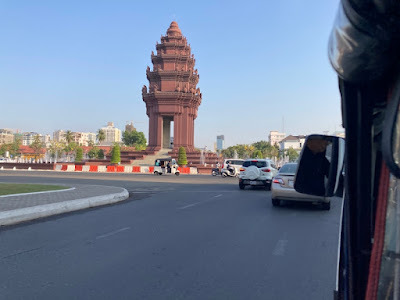 rotary design, Phnom Penh style
rotary design, Phnom Penh style
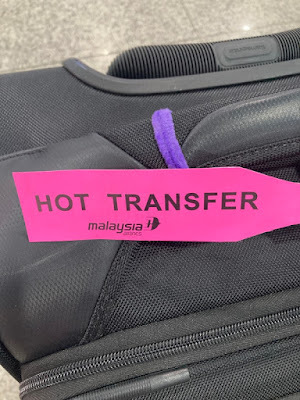 That it was, in more ways than one.When I was there, the lows were in the high 70s, highs in the mid-90s.
That it was, in more ways than one.When I was there, the lows were in the high 70s, highs in the mid-90s.
My Phnom Penh hotel, Baitong, was a form of a dream as well—no false notes. Wonderful staff, nicely designed, environmentally conscious, good food, the convenience of good food on site, cool rooftop for eating that food, a small bakery on site with nutless banana muffins (my favorite), even a tranquil “forest pool.”
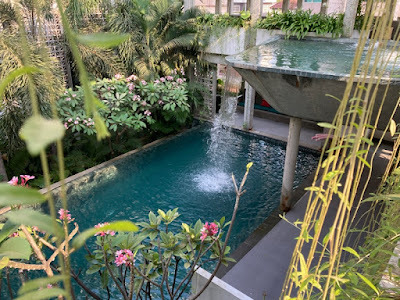
It also had a second, more traditional pool...except for the fact that you could look up into the pool from the lobby.
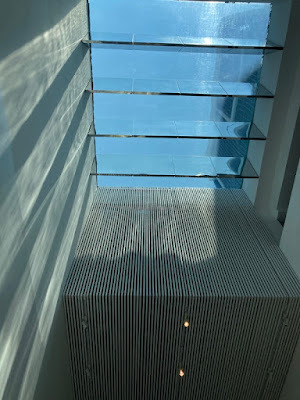
Soon after settling in, I set out for what would be the two most emotionally challenging stops of my three weeks in Asia: the Tuol Sleng Genocide Museum (formerly the S-21 torture prison, and before that, a high school) and the Killing Fields.
I went in knowing virtually nothing about Pol Pot and the Khmer Rouge, the Communist regime that tyrannized its own people from 1975 to 1979. For starters, I did know not “Khmer” is a term that some Cambodians use to refer to themselves and their language. And while I was familiar with the term “Killing Fields” (from the title of a movie I’ve never seen), I did not know that it refers to more than one site around the country, though it now seems obvious.
The prison was converted to a museum very quickly after the Vietnamese toppled Pol Pot’s rule. The place is almost unbearable. You walk throughout rooms where innocent people were tortured beyond human comprehension. In some spots you think you can almost still see the bloodstains on the floors and walls. At least 20,000 Cambodians suffered and were murdered there. The number known to have survived: 12.
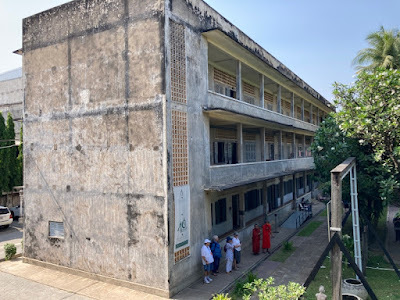
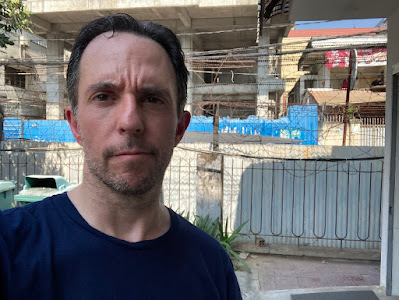 barbed wire
barbed wire
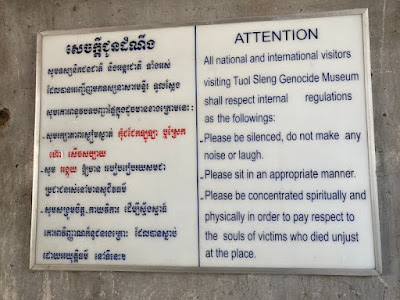
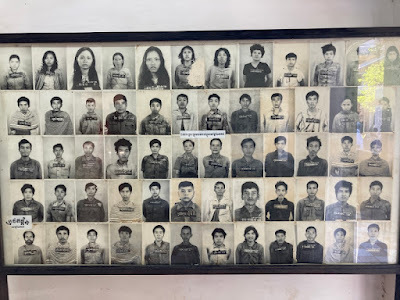 dozens of displays of victims
dozens of displays of victims
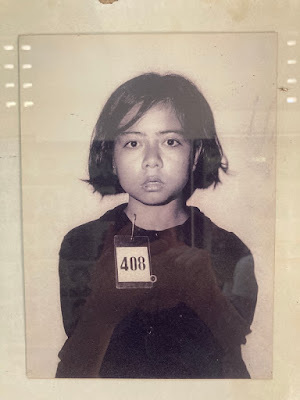 some were kids
some were kids
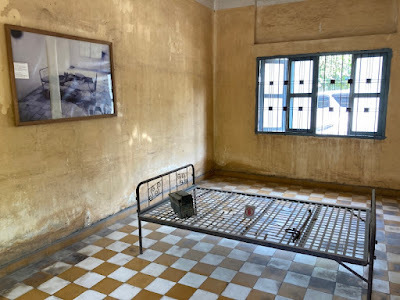 The photo on the wall shows the same room but with a victim. It was grotesque and profoundly sad.
The photo on the wall shows the same room but with a victim. It was grotesque and profoundly sad.
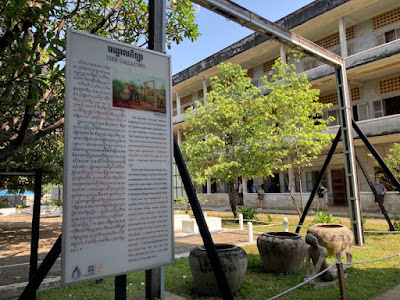
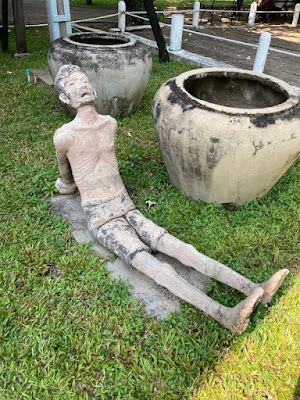
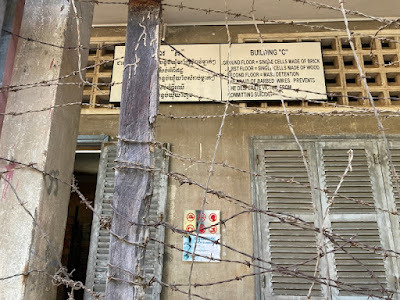
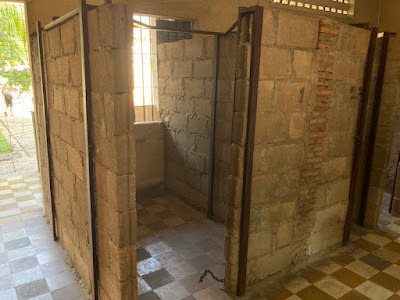
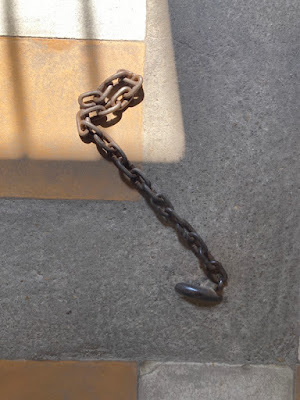
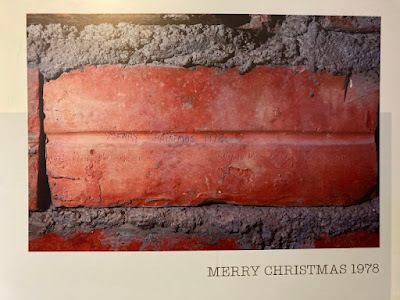
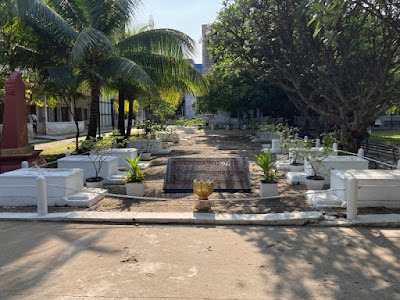
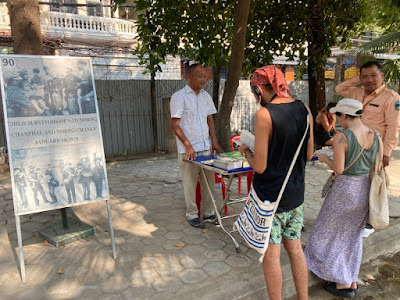 As a child, this man survived the prison and nowsells a book about his experience at the museum.
As a child, this man survived the prison and nowsells a book about his experience at the museum.
I visited the most well-known Killing Fields site, Choeung Ek, which is in Phnom Penh. Also nearly unbearable.
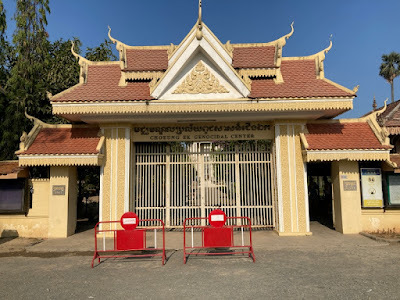
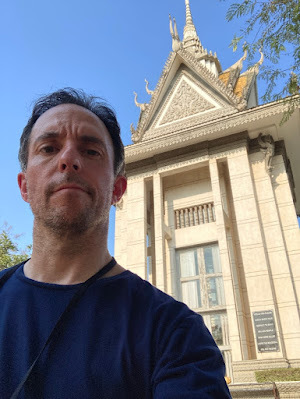 Buddhist stupa with grim contents
Buddhist stupa with grim contents
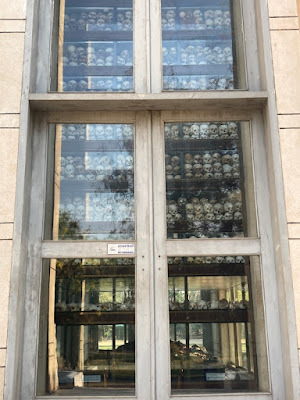
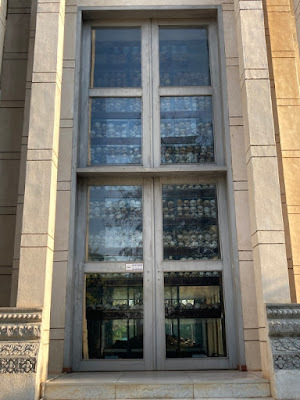
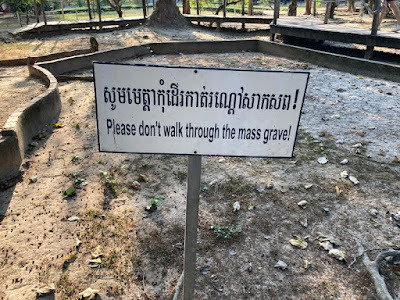
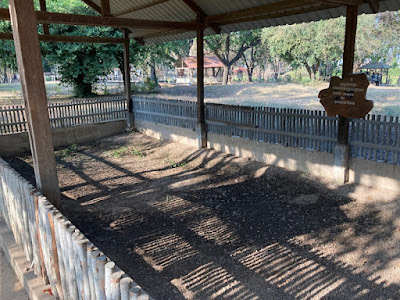
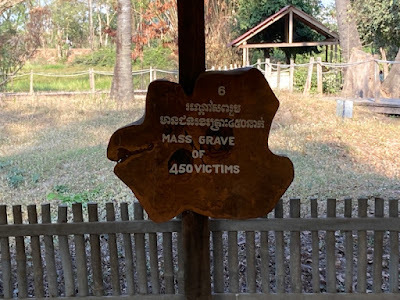
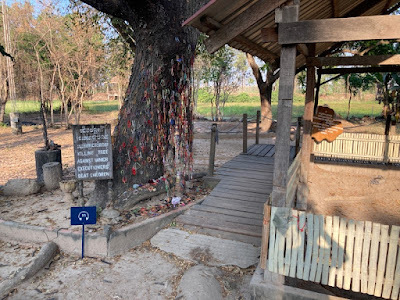
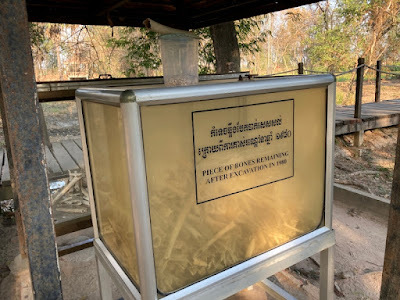
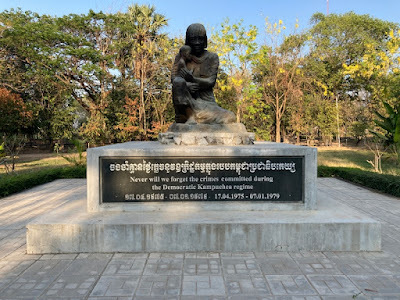
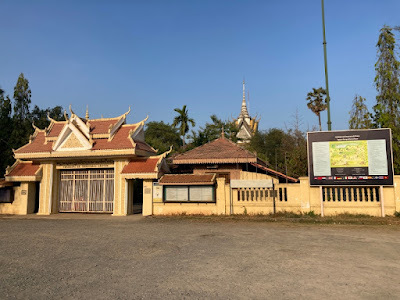
For the next three days, I spoke at two schools: Canadian International on Monday and Tuesday, Australian International on Wednesday. Yes, an American speaking at a Canadian and an Australian school in Cambodia. That’s some kind of punchline in the making. Yet for now, it was only a fulfilling round of assemblies and writing workshops with a largely Cambodian group of young people.
Though I’ve been to Asia multiple times before, including a similarly long trip in 2016 (that also included three countries, one of which was also Malaysia), this trip marked the first time I rode in a tuk-tuk (three-wheeled, motorized taxi common throughout Asia). It was how I got to and from CIS. With an app called Grab (comparable to Lyft), it was easy—and not nearly as loud or fast as I was expecting. The breeze was nice, too.
Thank you again to my hosts at both schools, Lisa and Stacy, for the enriching privilege of visiting your country. They took a chance on me on fairly short notice and I’m grateful. I was Stacy’s first in-person author since COVID, her first American author…and since she’s retiring at the end of the school year, her last author.
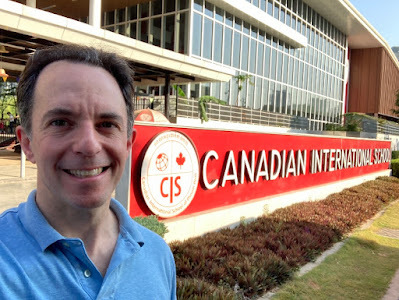
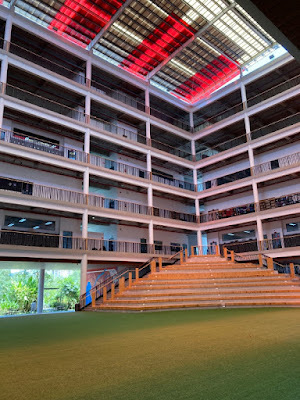
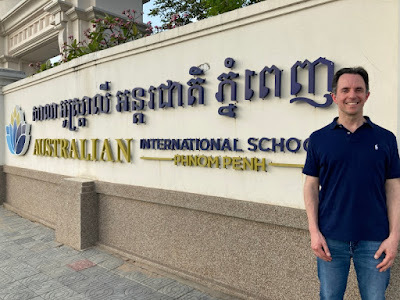
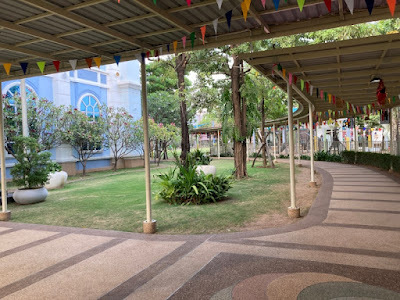
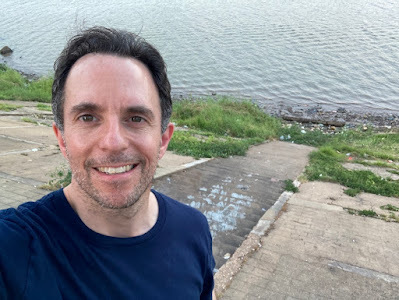 me and the Mekong River
me and the Mekong River
Taiwan—Taipei American School Malaysia—EARCOS conference (Kota Kinabalu)Malaysia—Survivor Island (Borneo)Cambodia—schools and history in Phnom PenhCambodia—Siem ReapCambodia—Angkor Wat/other temples
On 3/26/23, after a dream day on Survivor Island (Pulau Tiga off the coast of Borneo), I woke at 2:50 am for my 3:20 am ride to the airport for my 5:20 am flight to Phnom Penh. This would be my third week in Asia and my third country on the trip.
 rotary design, Phnom Penh style
rotary design, Phnom Penh style That it was, in more ways than one.When I was there, the lows were in the high 70s, highs in the mid-90s.
That it was, in more ways than one.When I was there, the lows were in the high 70s, highs in the mid-90s. My Phnom Penh hotel, Baitong, was a form of a dream as well—no false notes. Wonderful staff, nicely designed, environmentally conscious, good food, the convenience of good food on site, cool rooftop for eating that food, a small bakery on site with nutless banana muffins (my favorite), even a tranquil “forest pool.”

It also had a second, more traditional pool...except for the fact that you could look up into the pool from the lobby.

Soon after settling in, I set out for what would be the two most emotionally challenging stops of my three weeks in Asia: the Tuol Sleng Genocide Museum (formerly the S-21 torture prison, and before that, a high school) and the Killing Fields.
I went in knowing virtually nothing about Pol Pot and the Khmer Rouge, the Communist regime that tyrannized its own people from 1975 to 1979. For starters, I did know not “Khmer” is a term that some Cambodians use to refer to themselves and their language. And while I was familiar with the term “Killing Fields” (from the title of a movie I’ve never seen), I did not know that it refers to more than one site around the country, though it now seems obvious.
The prison was converted to a museum very quickly after the Vietnamese toppled Pol Pot’s rule. The place is almost unbearable. You walk throughout rooms where innocent people were tortured beyond human comprehension. In some spots you think you can almost still see the bloodstains on the floors and walls. At least 20,000 Cambodians suffered and were murdered there. The number known to have survived: 12.

 barbed wire
barbed wire
 dozens of displays of victims
dozens of displays of victims some were kids
some were kids The photo on the wall shows the same room but with a victim. It was grotesque and profoundly sad.
The photo on the wall shows the same room but with a victim. It was grotesque and profoundly sad.






 As a child, this man survived the prison and nowsells a book about his experience at the museum.
As a child, this man survived the prison and nowsells a book about his experience at the museum.I visited the most well-known Killing Fields site, Choeung Ek, which is in Phnom Penh. Also nearly unbearable.

 Buddhist stupa with grim contents
Buddhist stupa with grim contents








For the next three days, I spoke at two schools: Canadian International on Monday and Tuesday, Australian International on Wednesday. Yes, an American speaking at a Canadian and an Australian school in Cambodia. That’s some kind of punchline in the making. Yet for now, it was only a fulfilling round of assemblies and writing workshops with a largely Cambodian group of young people.
Though I’ve been to Asia multiple times before, including a similarly long trip in 2016 (that also included three countries, one of which was also Malaysia), this trip marked the first time I rode in a tuk-tuk (three-wheeled, motorized taxi common throughout Asia). It was how I got to and from CIS. With an app called Grab (comparable to Lyft), it was easy—and not nearly as loud or fast as I was expecting. The breeze was nice, too.
Thank you again to my hosts at both schools, Lisa and Stacy, for the enriching privilege of visiting your country. They took a chance on me on fairly short notice and I’m grateful. I was Stacy’s first in-person author since COVID, her first American author…and since she’s retiring at the end of the school year, her last author.




 me and the Mekong River
me and the Mekong River
Published on April 09, 2023 04:00
April 8, 2023
Visiting “Survivor Island,” Pulau Tiga, Malaysia
Part of a series: Asia, March 2023:
Taiwan—Taipei American School Malaysia—EARCOS conference (Kota Kinabalu)Malaysia—Survivor Island (Borneo)Cambodia—schools and history in Phnom PenhCambodia—Siem ReapCambodia—Angkor Wat/other temples
I’ve watched every episode of the U.S. version of Survivor. It debuted in 2000, and, except for fall 2020 and spring 2021 (for the obvious reason), has aired continuously since.
I planned not one but two Survivor-themed birthday parties for my daughter (age 10 and 12).
Yet I did not know till I landed in Kota Kinabalu, Malaysia to present at a conference how close I’d be to Survivor history.
In the short ride from the airport to the hotel, I heard or saw the word “Borneo” and my geography-challenged brain caught up.
Borneo is an island split among a trio of countries: Malaysia (including Kota Kinabalu), Brunei, and Indonesia. (The only one of the three that exists solely on Borneo is Brunei.)
Borneo—specifically a smaller island orbiting Borneo called Pulau Tiga—was the setting for the game-changing first U.S. season of Survivor.
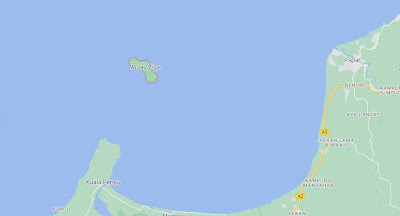
And Pulau Tiga was only 2.5 hours away from my KK hotel (two hours by car + 30 minutes by boat).
That meant I was going there, somehow.
I had only one available day—Saturday 3/25/23—and only the two days prior to arrange it.
Even when the first half-dozen tour companies I contacted said they currently don’t offer trips to Pulau Tiga, even when I was told that the one resort on the island had closed during the pandemic (which I guess was the explanation for why tours were no longer going there), even when multiple concierges at my hotel were unsuccessful in helping, I was undeterred.
(I would soon learn that there are at least two resorts there, both open.)
Thanks to intrepid traveloguer Justin Walter for trying to help me find a way there. (His own trip to Pulau Tiga in 2015 included some especially enviable moments.)
I went to bed early Friday night, not knowing if any plan would come together but wanting to be rested if it did.
I woke at 6 am and began my last-ditch attempts to make this happen. The kind driver who’d taken me to the hotel the first night connected me with someone named Alex, and thanks to Alex, I found both a ride to the jetty and a boat to the island. I set out before 9 am, almost as excited as if I was going to be on the show.
Almost immediately after we began to drive from Kota Kinabalu to the Kuala Penyu jetty, the driver I’d hired, Fitri, said he’d like to accompany me to the island. I said if the boat operator was okay with it, I’d be okay with it. He was a friendly person and offered to take photos for me, which is merciful for anyone reading this post because it means fewer selfies. He also spoke English, which was allayed some concern because I was told the boat operator—nickname PP—may not. (Turns out he did.)
Another small point of concern: because it was Ramadan (day 3), Fitri would not eat till after sunset. By his own admission, he could get woozier as the day went on. At the same time, he told me not to worry. Early in the drive, he said he was at about 90%.
Yet another concern: multiple user reviews online said the landing beach was dirty—littered with plastic and other trash that had washed up. I was relieved to see that was not the case—perhaps those who work on the island now do a better job keeping it clean than when those reviews were posted, or perhaps those reviews were inaccurate.
Seeing the island loom and first stepping foot there were instant life highlights for this pop culture archaeologist.
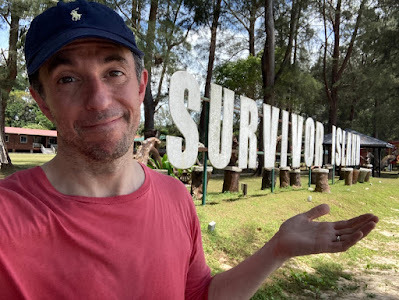
I managed to miss not one but three animals that I have never seen in person: a whale shark as we drove to the island, a green (non-venomous) snake on the island, and a monitor lizard on the jetty upon our return. The whale shark went in a different direction and the other two split when they saw humans but before this human saw them.
Roughly halfway through my exploration, Fitri said he was then at 60%. But he rallied and we made it back without incident.
This ended up being the priciest of the seven day excursions (Taiwan: Yangmingshan, Taroko, JCC, Tianmu Trail; Malaysia: this; Cambodia: Killing Fields, Angkor Wat/temples) during my three weeks in Asia; the cost breakdown, in ringgits:
10 tip for concierge450 taxi110 tip for taxi driver1000 boat50 tip for boat operator10 entrance to the area with volcanic mud20 conservation fee
This equals about $375. And totally worth it.
Only after my trip did I find out that Alex worked on season 1 of Survivor. Naturally I sent him a bunch of questions, and if he answers any, I may share that here.
The illustrated highlights:
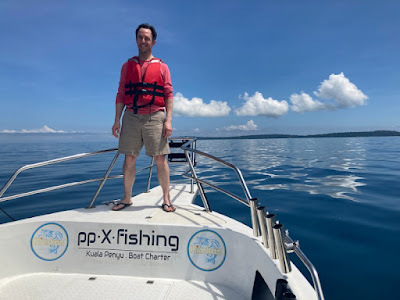 King of the world. Wait, wrong cultural touchstone.
King of the world. Wait, wrong cultural touchstone.
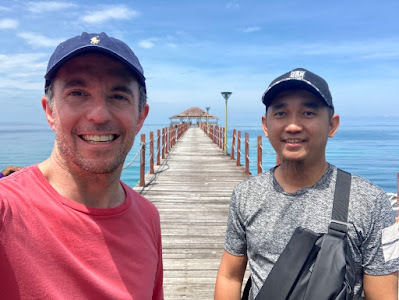 Meet Fitri, driver and fellow explorer.
Meet Fitri, driver and fellow explorer.
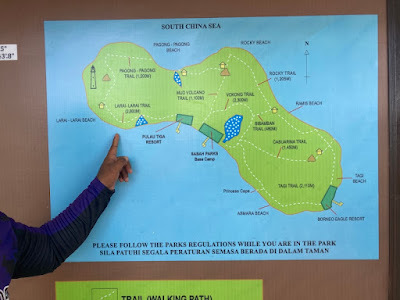
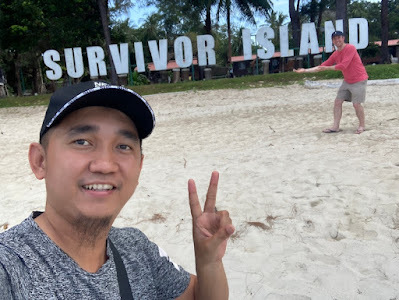
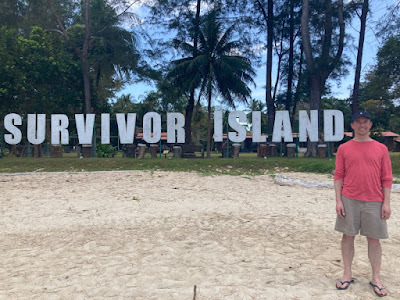
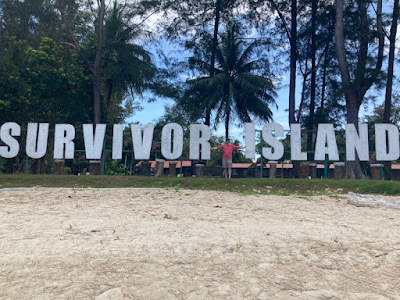 Yes, I had to document the sign in multiple ways.
Yes, I had to document the sign in multiple ways.
(It obviously was not even there when the contestants were.)
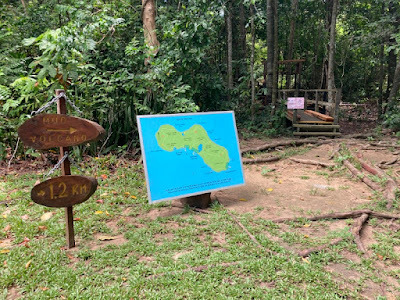 start of the path to the volcanic mud,which some Survivors rolled around in
start of the path to the volcanic mud,which some Survivors rolled around in
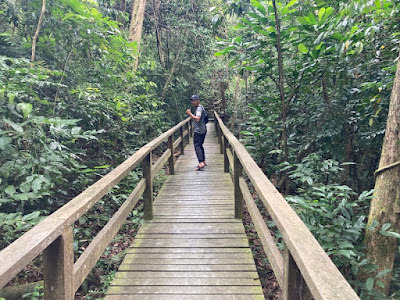
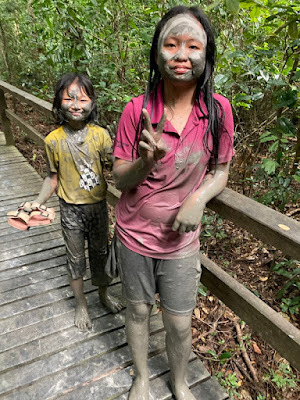 new volcanic mud bath survivors
new volcanic mud bath survivors
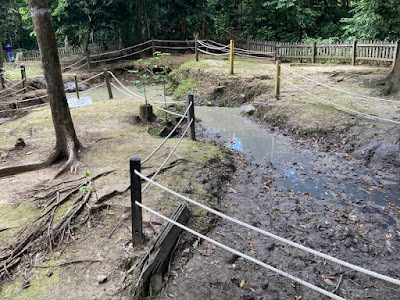
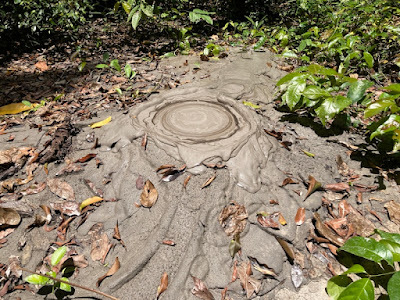 newly formed mud eruption(hard to gauge scale in this photo, but it is fairly small)
newly formed mud eruption(hard to gauge scale in this photo, but it is fairly small)
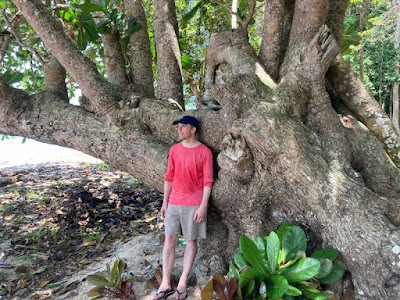
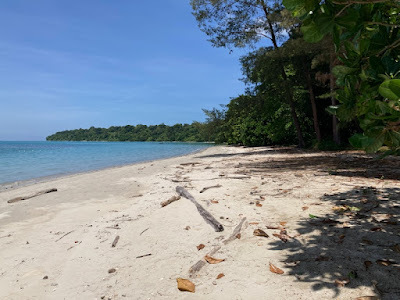
Here stood the first Tribal Council:
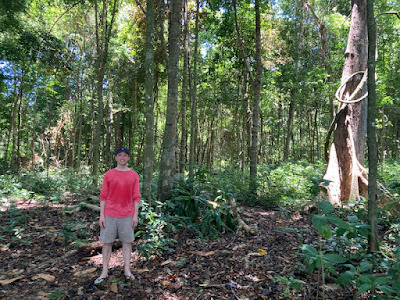
No trace of the set now, except perhaps a certain tree that only the most fervent of fans would pinpoint. The walk from the camps to here would have taken an estimated hour and a half.
The Survivor crew spent about four months on the island. After they cleared out in 2000, their quarters were converted to a resort, which has since closed. But others have risen elsewhere on the island, while the ruins of this one beckon intrepid explorers—and bats. (If this was in my neck of the world, it would surely be fenced off or demolished. Some of the floors had rotted and could easily give out from under you.)
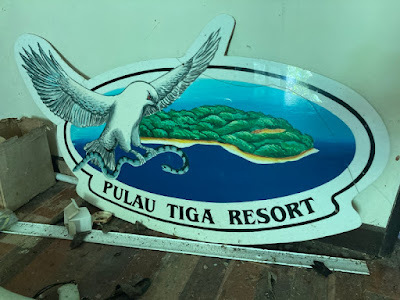
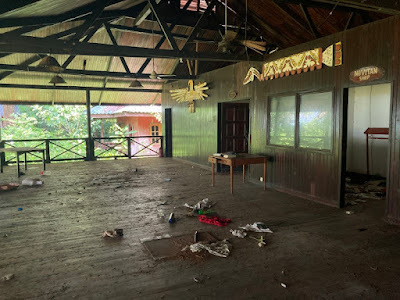
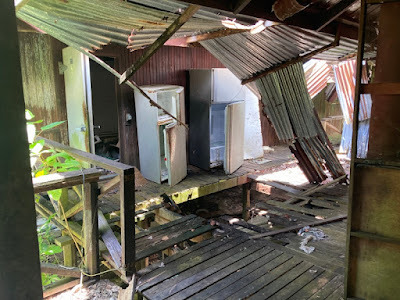
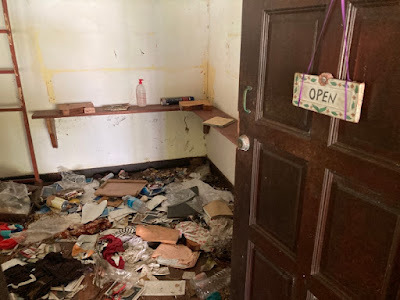
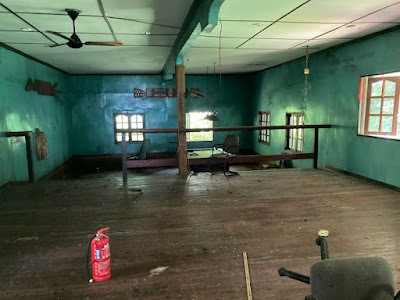 once a game/karaoke room
once a game/karaoke room
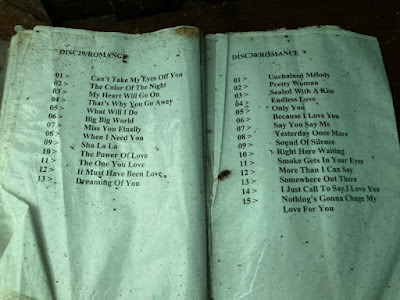
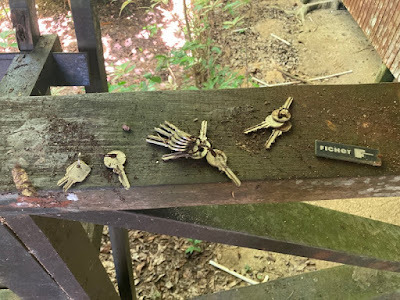 abandoned keys were everywhere
abandoned keys were everywhere
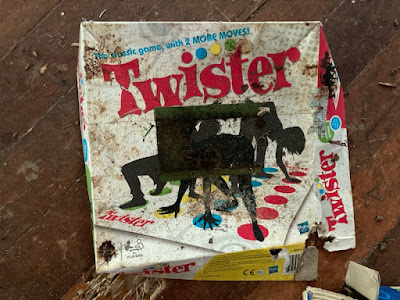
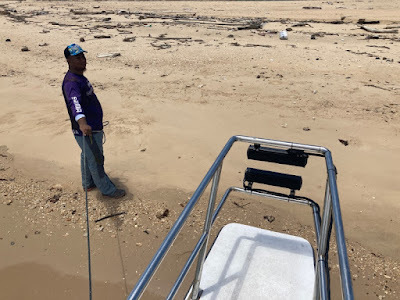 Meet boat operator PP.
Meet boat operator PP.
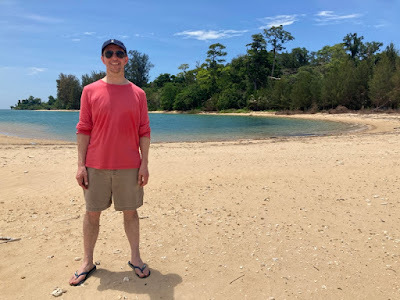 Tagi Beach, home to one of the two season 1 tribes (including eventual winner Richard Hatch)
Tagi Beach, home to one of the two season 1 tribes (including eventual winner Richard Hatch)
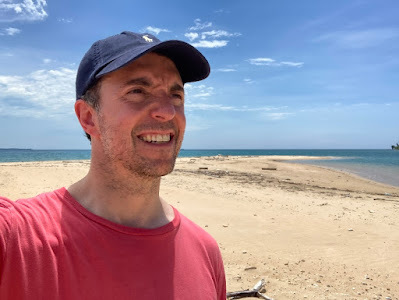 Squint Eastwood.
Squint Eastwood.
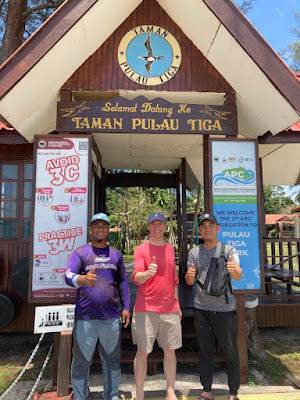 reviewing the day with PP and Fitri
reviewing the day with PP and Fitri
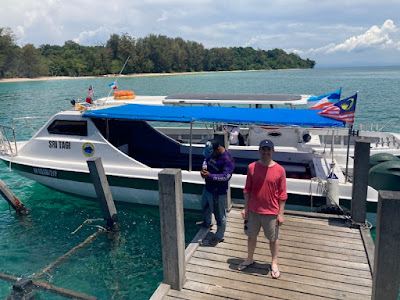
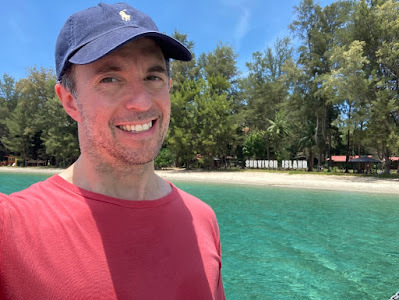 voted off the island
voted off the island
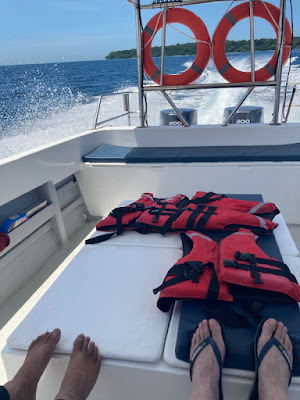
So long, Survivor Island, birthplace of a phenomenon.
Taiwan—Taipei American School Malaysia—EARCOS conference (Kota Kinabalu)Malaysia—Survivor Island (Borneo)Cambodia—schools and history in Phnom PenhCambodia—Siem ReapCambodia—Angkor Wat/other temples
I’ve watched every episode of the U.S. version of Survivor. It debuted in 2000, and, except for fall 2020 and spring 2021 (for the obvious reason), has aired continuously since.
I planned not one but two Survivor-themed birthday parties for my daughter (age 10 and 12).
Yet I did not know till I landed in Kota Kinabalu, Malaysia to present at a conference how close I’d be to Survivor history.
In the short ride from the airport to the hotel, I heard or saw the word “Borneo” and my geography-challenged brain caught up.
Borneo is an island split among a trio of countries: Malaysia (including Kota Kinabalu), Brunei, and Indonesia. (The only one of the three that exists solely on Borneo is Brunei.)
Borneo—specifically a smaller island orbiting Borneo called Pulau Tiga—was the setting for the game-changing first U.S. season of Survivor.

And Pulau Tiga was only 2.5 hours away from my KK hotel (two hours by car + 30 minutes by boat).
That meant I was going there, somehow.
I had only one available day—Saturday 3/25/23—and only the two days prior to arrange it.
Even when the first half-dozen tour companies I contacted said they currently don’t offer trips to Pulau Tiga, even when I was told that the one resort on the island had closed during the pandemic (which I guess was the explanation for why tours were no longer going there), even when multiple concierges at my hotel were unsuccessful in helping, I was undeterred.
(I would soon learn that there are at least two resorts there, both open.)
Thanks to intrepid traveloguer Justin Walter for trying to help me find a way there. (His own trip to Pulau Tiga in 2015 included some especially enviable moments.)
I went to bed early Friday night, not knowing if any plan would come together but wanting to be rested if it did.
I woke at 6 am and began my last-ditch attempts to make this happen. The kind driver who’d taken me to the hotel the first night connected me with someone named Alex, and thanks to Alex, I found both a ride to the jetty and a boat to the island. I set out before 9 am, almost as excited as if I was going to be on the show.
Almost immediately after we began to drive from Kota Kinabalu to the Kuala Penyu jetty, the driver I’d hired, Fitri, said he’d like to accompany me to the island. I said if the boat operator was okay with it, I’d be okay with it. He was a friendly person and offered to take photos for me, which is merciful for anyone reading this post because it means fewer selfies. He also spoke English, which was allayed some concern because I was told the boat operator—nickname PP—may not. (Turns out he did.)
Another small point of concern: because it was Ramadan (day 3), Fitri would not eat till after sunset. By his own admission, he could get woozier as the day went on. At the same time, he told me not to worry. Early in the drive, he said he was at about 90%.
Yet another concern: multiple user reviews online said the landing beach was dirty—littered with plastic and other trash that had washed up. I was relieved to see that was not the case—perhaps those who work on the island now do a better job keeping it clean than when those reviews were posted, or perhaps those reviews were inaccurate.
Seeing the island loom and first stepping foot there were instant life highlights for this pop culture archaeologist.

I managed to miss not one but three animals that I have never seen in person: a whale shark as we drove to the island, a green (non-venomous) snake on the island, and a monitor lizard on the jetty upon our return. The whale shark went in a different direction and the other two split when they saw humans but before this human saw them.
Roughly halfway through my exploration, Fitri said he was then at 60%. But he rallied and we made it back without incident.
This ended up being the priciest of the seven day excursions (Taiwan: Yangmingshan, Taroko, JCC, Tianmu Trail; Malaysia: this; Cambodia: Killing Fields, Angkor Wat/temples) during my three weeks in Asia; the cost breakdown, in ringgits:
10 tip for concierge450 taxi110 tip for taxi driver1000 boat50 tip for boat operator10 entrance to the area with volcanic mud20 conservation fee
This equals about $375. And totally worth it.
Only after my trip did I find out that Alex worked on season 1 of Survivor. Naturally I sent him a bunch of questions, and if he answers any, I may share that here.
The illustrated highlights:
 King of the world. Wait, wrong cultural touchstone.
King of the world. Wait, wrong cultural touchstone. Meet Fitri, driver and fellow explorer.
Meet Fitri, driver and fellow explorer.


 Yes, I had to document the sign in multiple ways.
Yes, I had to document the sign in multiple ways. (It obviously was not even there when the contestants were.)
 start of the path to the volcanic mud,which some Survivors rolled around in
start of the path to the volcanic mud,which some Survivors rolled around in
 new volcanic mud bath survivors
new volcanic mud bath survivors
 newly formed mud eruption(hard to gauge scale in this photo, but it is fairly small)
newly formed mud eruption(hard to gauge scale in this photo, but it is fairly small)

Here stood the first Tribal Council:

No trace of the set now, except perhaps a certain tree that only the most fervent of fans would pinpoint. The walk from the camps to here would have taken an estimated hour and a half.
The Survivor crew spent about four months on the island. After they cleared out in 2000, their quarters were converted to a resort, which has since closed. But others have risen elsewhere on the island, while the ruins of this one beckon intrepid explorers—and bats. (If this was in my neck of the world, it would surely be fenced off or demolished. Some of the floors had rotted and could easily give out from under you.)




 once a game/karaoke room
once a game/karaoke room
 abandoned keys were everywhere
abandoned keys were everywhere
 Meet boat operator PP.
Meet boat operator PP. Tagi Beach, home to one of the two season 1 tribes (including eventual winner Richard Hatch)
Tagi Beach, home to one of the two season 1 tribes (including eventual winner Richard Hatch) Squint Eastwood.
Squint Eastwood. reviewing the day with PP and Fitri
reviewing the day with PP and Fitri
 voted off the island
voted off the island
So long, Survivor Island, birthplace of a phenomenon.
Published on April 08, 2023 04:00
April 7, 2023
EARCOS conference 2023, Kota Kinabalu, Malaysia
Part of a series: Asia, March 2023:
Taiwan—Taipei American School Malaysia—EARCOS conference (Kota Kinabalu)Malaysia—Survivor Island (Borneo)Cambodia—schools and history in Phnom PenhCambodia—Siem ReapCambodia—Angkor Wat/other temples
After seven days of speaking (within which my record was seven times in one day) at the Taipei American School, I flew to Kota Kinabalu, Malaysia, which has a much different vibe than the other part of Malaysia I’d visited, Kuala Lumpur. KL is urban (though has a natural side). KK is coastal (though likely has a downtown of some kind).
Not that speaking is ever a grind for me, but it felt even less like work in this setting: a resort in a tropical paradise on the South China Sea. (“Coastal” undersold it.)
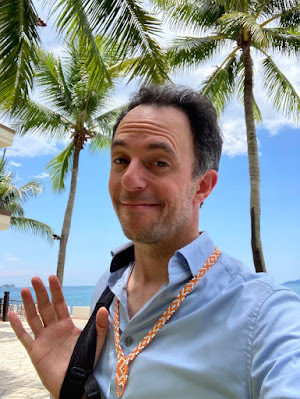
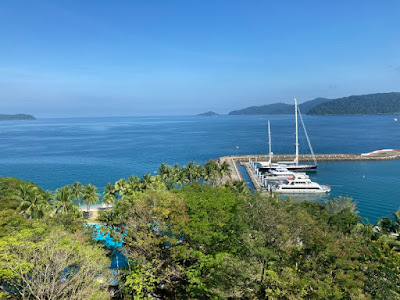 view from my room
view from my room
I was one of two children’s authors speaking at a conference called EARCOS (East Asia Regional Council of Schools), the other being the epically kind Susan Tan.
I was originally scheduled for 2021—but COVID. So I was (conditionally) rescheduled for 2022—but still COVID.
My appearances were spread over two days, consisting of two talks and a screening of Batman & Bill in a huge banquet hall, after which I did a short Q&A.
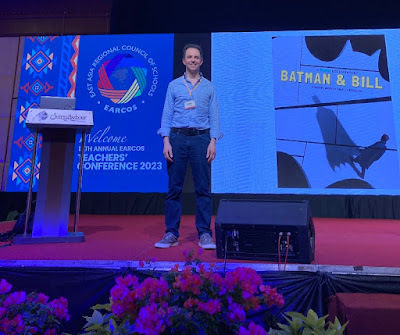
The morning before my first talk, I puttered around the harbor.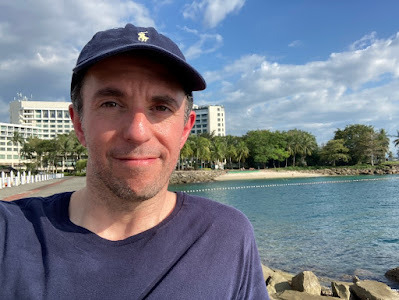
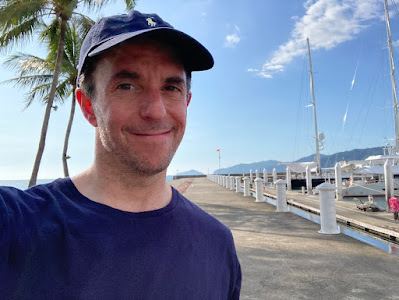
Both afternoons after my commitments, I changed into shorts and got a smoothie at the pool (no line but no rush—took about 20 minutes). The second evening, I watched the sunset over the ocean from the small beach in the “backyard” of the hotel.
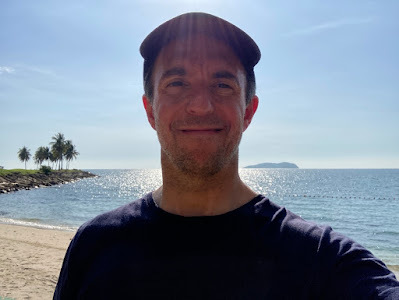
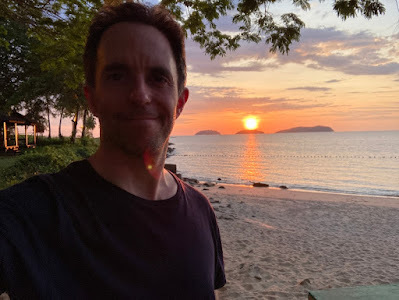
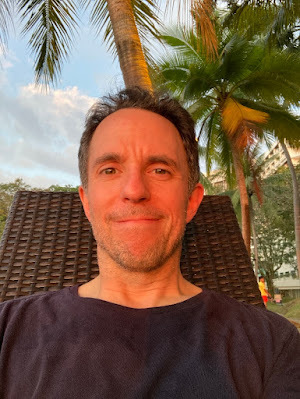
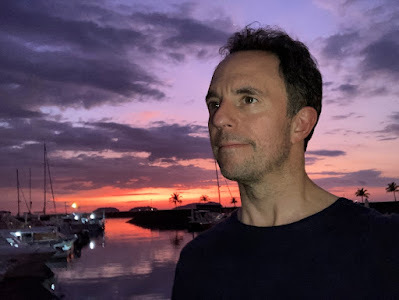
Possibly the best photo I took over my three weeks in Asia:
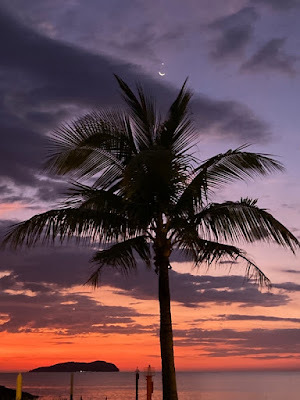
One friend commented that the moon and what looks like a star are close to forming the crescent and star symbol of Islam. (Malaysia is a Muslim country.)
But it is not a star. The same friend noted the possible “occultation,” when the move passes in front of another celestrial body—in this case, Venus.
One of my favorite aspects of Malaysia was how grateful locals are when you say “thank you” in Malay (“terima kasih”).
Terima kasih again to Ed Greene and Kristine De Castro for the invitation and for throwing a great conference/party.
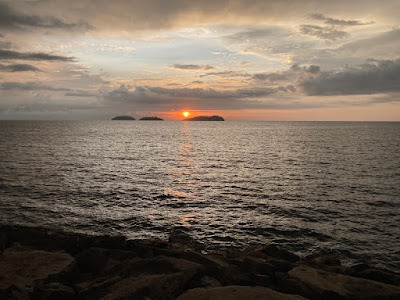
Oh, the reason I couldn’t say for sure if Kota Kinabalu has a developed downtown is because I did not leave the resort for my three days there—with one exception.
Survivor Island.
Taiwan—Taipei American School Malaysia—EARCOS conference (Kota Kinabalu)Malaysia—Survivor Island (Borneo)Cambodia—schools and history in Phnom PenhCambodia—Siem ReapCambodia—Angkor Wat/other temples
After seven days of speaking (within which my record was seven times in one day) at the Taipei American School, I flew to Kota Kinabalu, Malaysia, which has a much different vibe than the other part of Malaysia I’d visited, Kuala Lumpur. KL is urban (though has a natural side). KK is coastal (though likely has a downtown of some kind).
Not that speaking is ever a grind for me, but it felt even less like work in this setting: a resort in a tropical paradise on the South China Sea. (“Coastal” undersold it.)

 view from my room
view from my roomI was one of two children’s authors speaking at a conference called EARCOS (East Asia Regional Council of Schools), the other being the epically kind Susan Tan.
I was originally scheduled for 2021—but COVID. So I was (conditionally) rescheduled for 2022—but still COVID.
My appearances were spread over two days, consisting of two talks and a screening of Batman & Bill in a huge banquet hall, after which I did a short Q&A.

The morning before my first talk, I puttered around the harbor.


Both afternoons after my commitments, I changed into shorts and got a smoothie at the pool (no line but no rush—took about 20 minutes). The second evening, I watched the sunset over the ocean from the small beach in the “backyard” of the hotel.




Possibly the best photo I took over my three weeks in Asia:

One friend commented that the moon and what looks like a star are close to forming the crescent and star symbol of Islam. (Malaysia is a Muslim country.)
But it is not a star. The same friend noted the possible “occultation,” when the move passes in front of another celestrial body—in this case, Venus.
One of my favorite aspects of Malaysia was how grateful locals are when you say “thank you” in Malay (“terima kasih”).
Terima kasih again to Ed Greene and Kristine De Castro for the invitation and for throwing a great conference/party.

Oh, the reason I couldn’t say for sure if Kota Kinabalu has a developed downtown is because I did not leave the resort for my three days there—with one exception.
Survivor Island.
Published on April 07, 2023 14:48
March 20, 2023
My 2020 trip to Taiwan, 2023 style
In late 2019, the Taipei American School booked me to speak in November 2020.
That didn’t happen. You know why.
The invitation was tentatively rescheduled for 2021, then with even less certainty for 2022, and finally for March 13-21, 2023—four days with elementary, three days with middle.
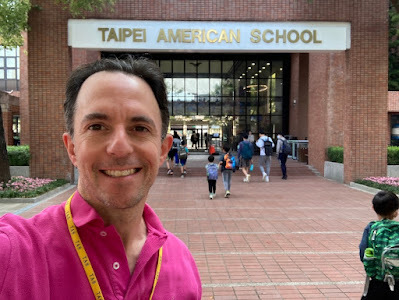
You’d think the pandemic would have maxed out the bad luck regarding this trip, but no…three days before my first day at the school, one of my three librarian hosts had to fly home to America for a family emergency. The day before my first day at the school, another of my hosts got COVID. After my second day at the school, my third host got food poisoning!
I missed the first host altogether; the third was out for only a day and the second was able to return to work for my last two days.
On the other side of the luck coin, the mask mandate in Taiwan was lifted one week before I arrived. I was not looking forward to presenting with mouth covered four to six hours a day for seven days. (I realize that’s what teachers in Taiwan and elsewhere have been doing for nearly three years. Yet another reason to treat educators with reverence.)
It was all worth it. The school, the kids, the culture have all been so welcoming. Not once but twice, a stranger handed me coins to pay for a matter at hand. When I was running and was somehow unable to find the huge river that runs through the area, I asked a boy of about 14 who was riding his bike if he could point me in the right direction. He spoke little English but said “together”—then gestured for me to run alongside him. He took me to the river, then took a selfie of us, then went on his way.
In what quickly became my favorite (if unadventurously Western) local spot—a French bakery—a local couple came up to me and asked if I’m Marc. The bakery, my hotel, and the school are within easy walking distance of each other and these nice people knew an American author was speaking at the school. I clearly stood out. In fact, in most environments here (subway, restaurants, my hotel), I am almost always the only person in sight who presents as non-Asian.
Cultural observations:
virtually no public trash cans—or trash on the streetsunbelievably safe; I walked through unfamiliar dark winding streets at night without concernuneven sidewalks; they’re paved or tiled nicely but can suddenly rise up or downin bakeries, you take your own item with tongs, place it on a tray, and bring that to the counter to be bagged7-Eleven is more than a convenience store here; it’s the hub of life; people dine in, buy train tickets, pay bills, and more, and at times there’s one every few blocksmany locals speak more English than they admit toI’m hearing little to no fear of China invading; as one Taiwanese person told me, “They’ve been talking about this for 30 years and nothing has happened”; this cover suggests otherwise:
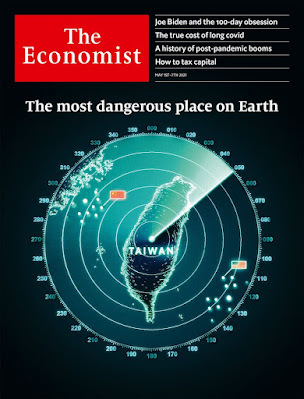 My hosts said day-to-day life carries on without dread.
My hosts said day-to-day life carries on without dread.
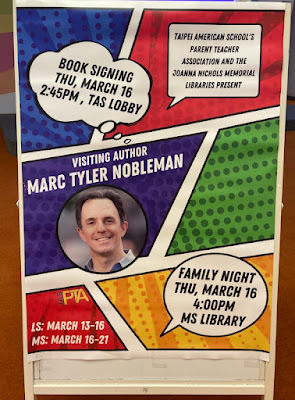
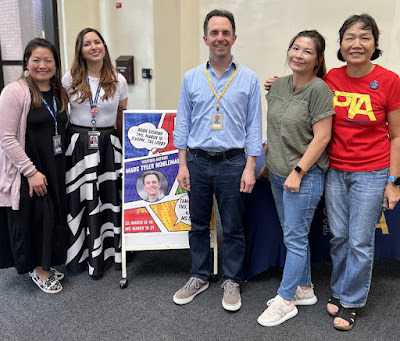 With some of my hosts, both staff and PTA.
With some of my hosts, both staff and PTA.
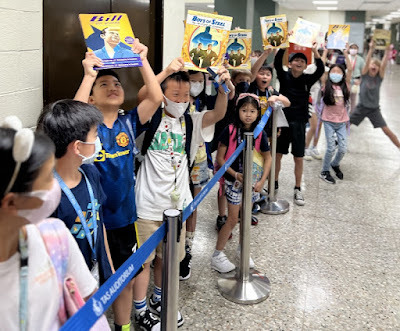
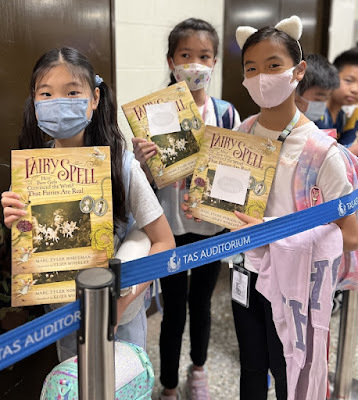
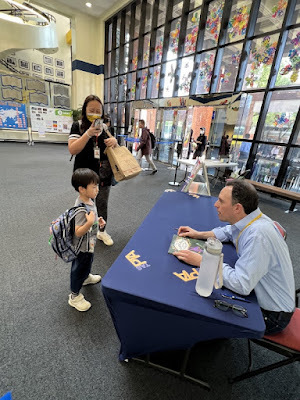
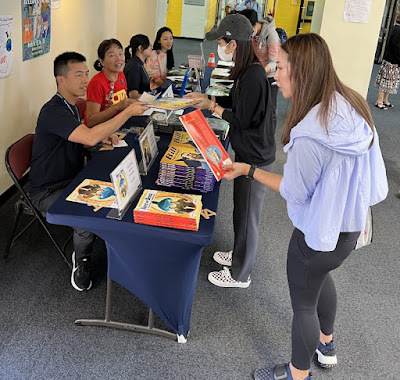
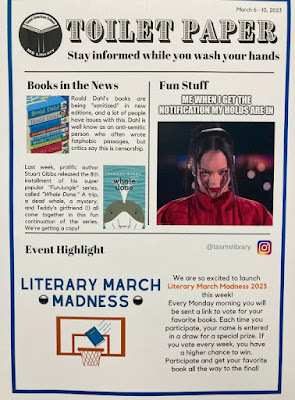 Carol Youssif, middle school librarian, produces this clever newsletter and posts it(you guessed it) in the bathroom.
Carol Youssif, middle school librarian, produces this clever newsletter and posts it(you guessed it) in the bathroom.
Friends who have visited TAS ahead of me:
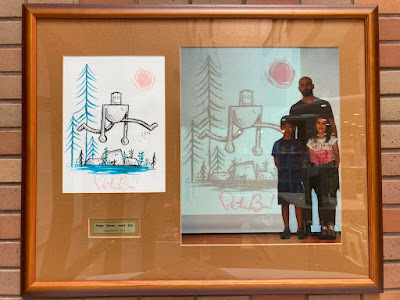 Peter Brown
Peter Brown
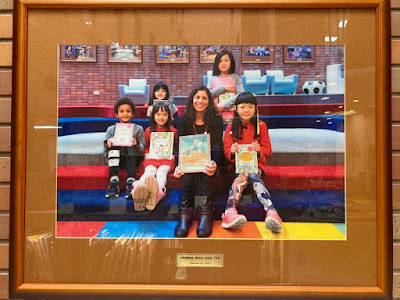 Marissa Moss
Marissa Moss
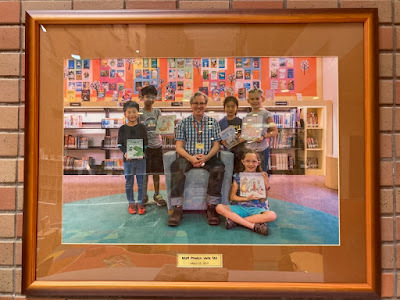 Matt Phelan
Matt Phelan
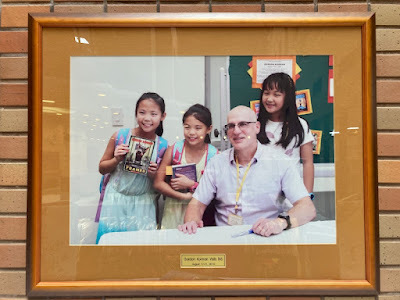 Gordon Korman
Gordon Korman
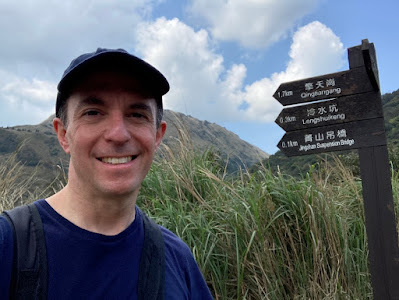 Beginning my hiking exploration at Yangmishan National Park in Taipei.
Beginning my hiking exploration at Yangmishan National Park in Taipei.
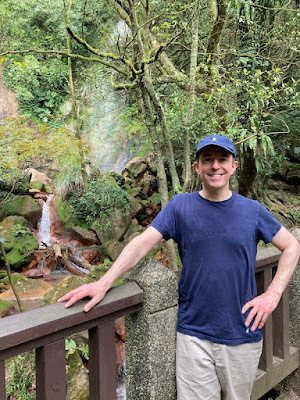
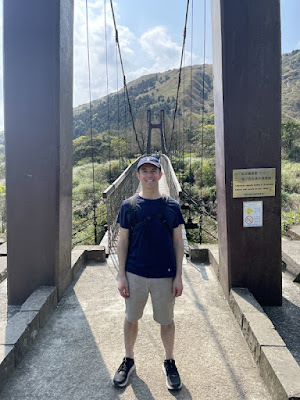 My first of three suspension bridges in Taiwan.
My first of three suspension bridges in Taiwan.
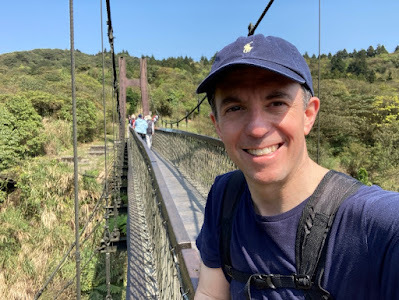
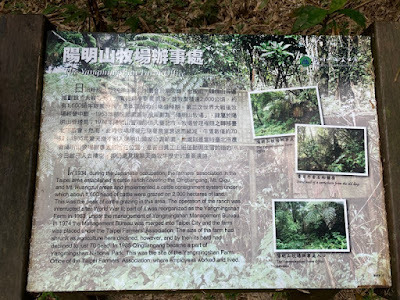
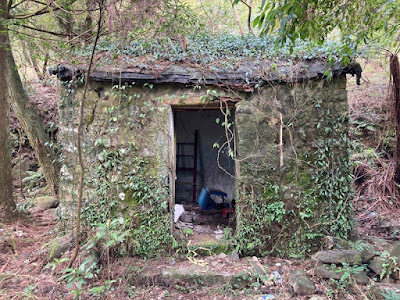
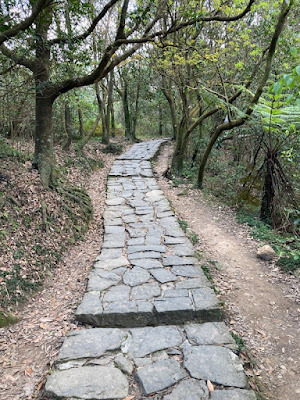 I loved the various styles of paths in the park.
I loved the various styles of paths in the park.
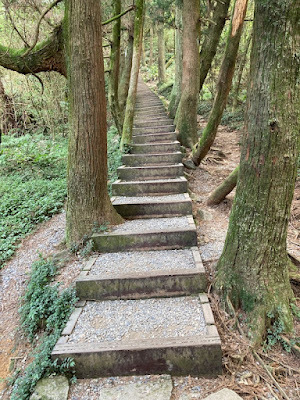
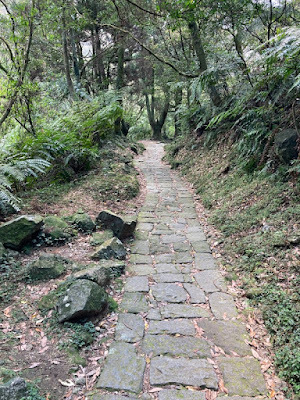
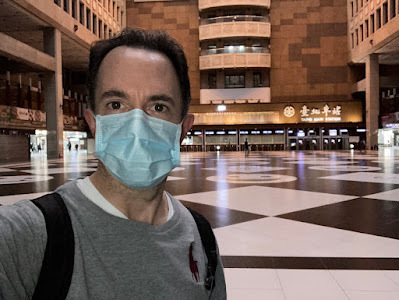 I woke at 5:15 am to take a three-hour train from Taipei toHualein, then a 30-minute drive to Taroko National Park.This is Taipei Main Station at 6:30 am.
I woke at 5:15 am to take a three-hour train from Taipei toHualein, then a 30-minute drive to Taroko National Park.This is Taipei Main Station at 6:30 am.
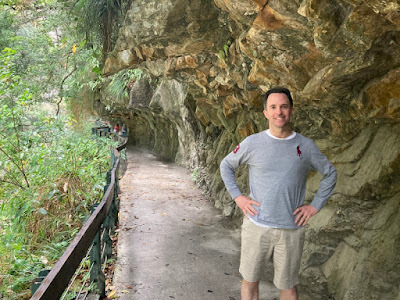 My first trail in Taroko.
My first trail in Taroko.
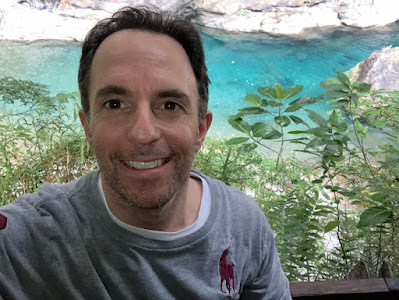 Due to the marble cliffs and other natural chemicals,some of the water in the gorge is Caribbean/South Pacific blue.
Due to the marble cliffs and other natural chemicals,some of the water in the gorge is Caribbean/South Pacific blue.
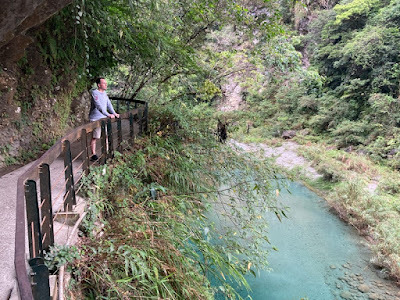
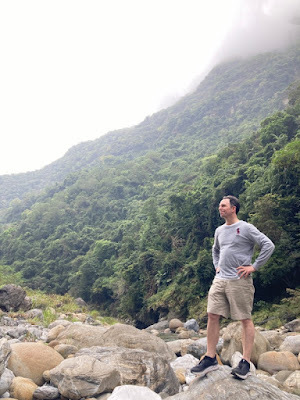
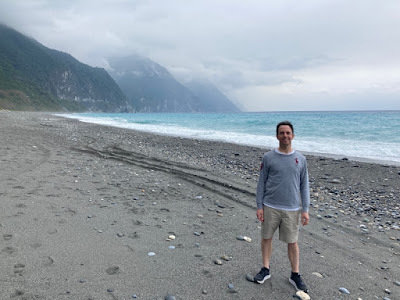 Pacific Ocean
Pacific Ocean
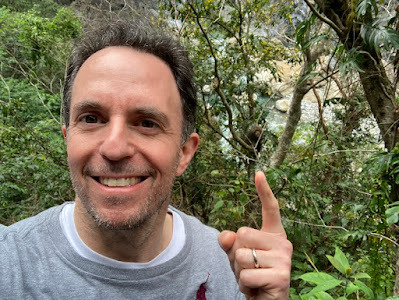 See who I met?
See who I met?
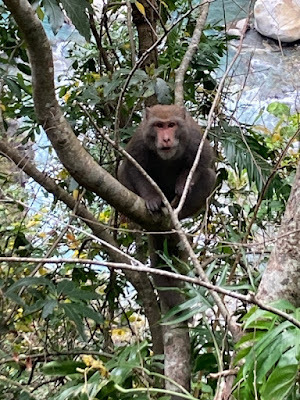
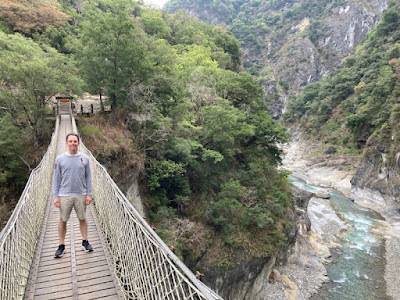 My second (and favorite) of three suspension bridges.(Third not pictured in this post.)
My second (and favorite) of three suspension bridges.(Third not pictured in this post.)
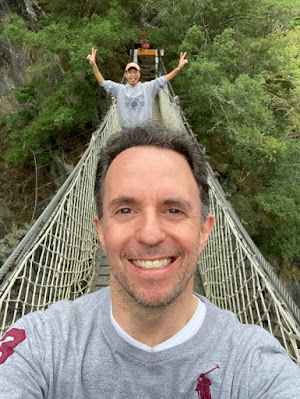 Can you spot my tour guide Ivan?
Can you spot my tour guide Ivan?
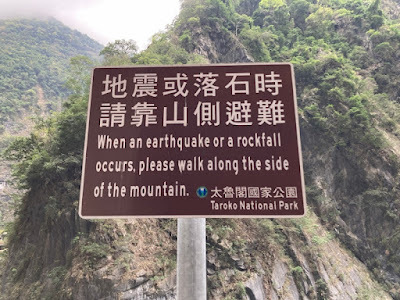
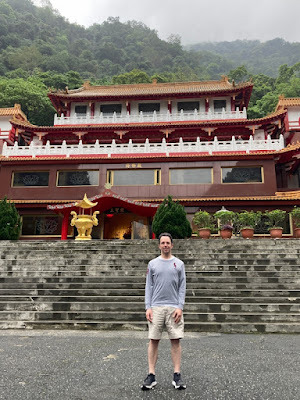 A monastery in the rainforest.
A monastery in the rainforest.
So yes, in one day, in one park, I encountered a rainforest, a monastery, gorges, suspension bridges, monkeys, and even the other side of the Pacific Ocean.
The librarian who had to return to the States had been planning to take me to a new Jewish institution in Taipei called the Jeffrey D. Schwartz Jewish Community Center—indeed the first Jewish house of worship in all of Taiwan. But it’s more than a synagogue. It’s also home to a museum of Jewish art and Judaica, a kosher culinary lab (AKA a restaurant), a mikveh (ritual bath), banquet and meeting halls, education spaces, and an apartment for the (Israeli/Orthodox) rabbi, his wife, and their six kids.
Logically, my tour guide was a non-Jewish Austrian.
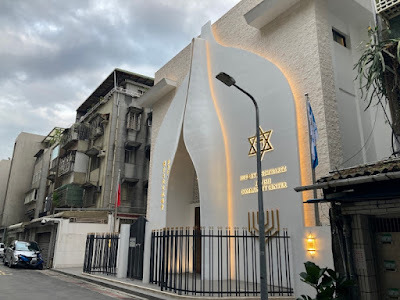
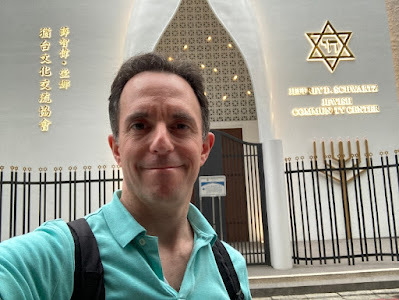
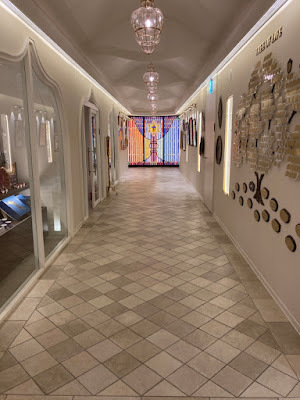
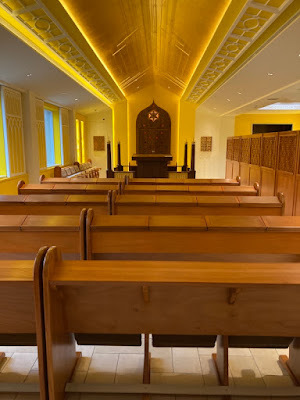
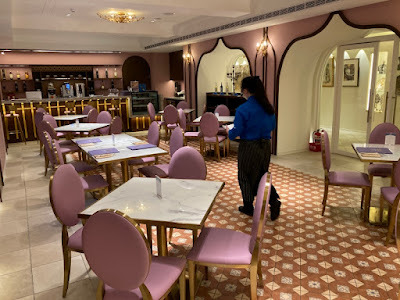
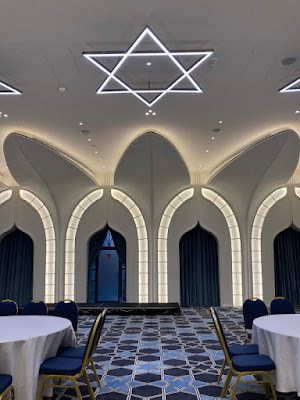
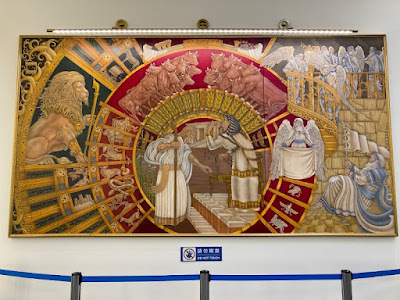
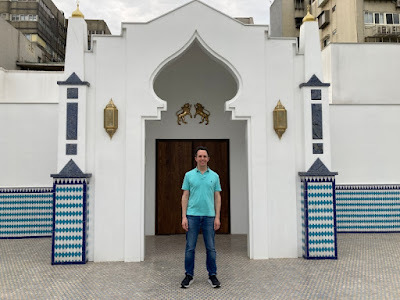
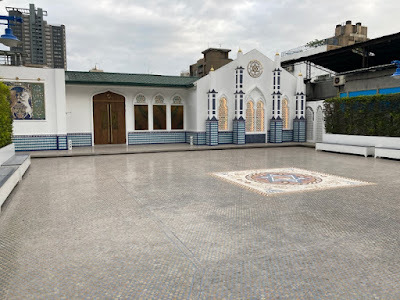
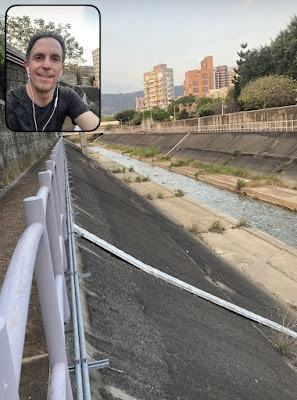 I ran along this canal.
I ran along this canal.
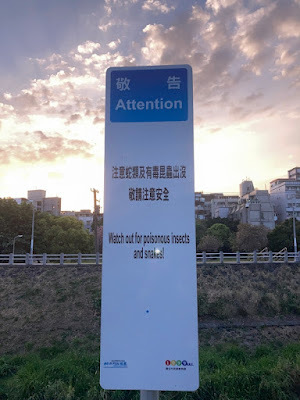 I did not run into any poisonous critters.
I did not run into any poisonous critters.
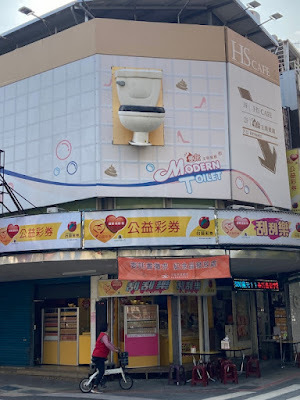 Modern Toilet is...a restaurant.
Modern Toilet is...a restaurant.
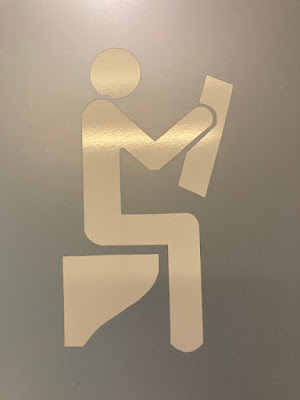 Speaking of toilets, my hotel room had its ownlittle library.
Speaking of toilets, my hotel room had its ownlittle library.
 Some pizza had bizarrelyAmerican toppings that you do noteven see in America.
Some pizza had bizarrelyAmerican toppings that you do noteven see in America.
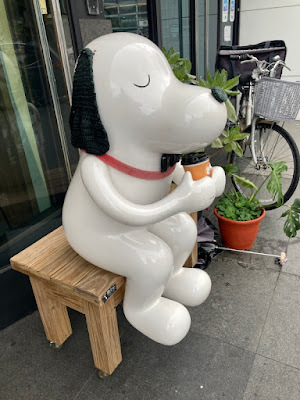 Peanuts is popular here. I saw Snoopyon many a T-shirt...and one bench (though it is not an exact likeness).
Peanuts is popular here. I saw Snoopyon many a T-shirt...and one bench (though it is not an exact likeness).
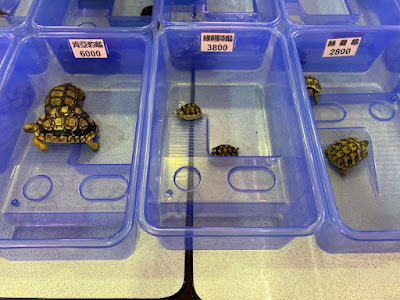 Turtles for sale.
Turtles for sale.
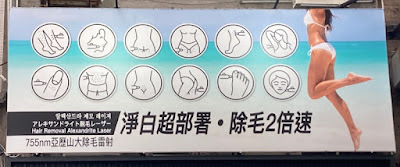 This sign leaves little about hair removal to the imagination.
This sign leaves little about hair removal to the imagination.
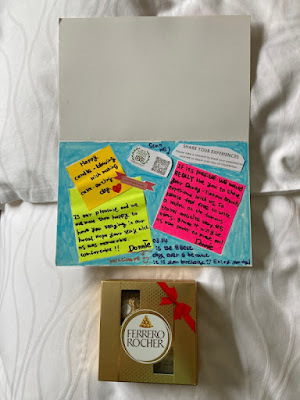 The sweet, handwritten greeting my hotel left me on my birthday.
The sweet, handwritten greeting my hotel left me on my birthday.
Thank you again to librarians Brianna, Carol, and Mandy for the years of prep, the warm welcome, the overall wonderful experience. Thank you also to the many more who took care of me throughout including Ashley, Suji, Fantine, Cecilia, Rick, Becky, Erik, Kiley, Adrienne, Paul, Diane, Savanna...
I shall be back.
That didn’t happen. You know why.
The invitation was tentatively rescheduled for 2021, then with even less certainty for 2022, and finally for March 13-21, 2023—four days with elementary, three days with middle.

You’d think the pandemic would have maxed out the bad luck regarding this trip, but no…three days before my first day at the school, one of my three librarian hosts had to fly home to America for a family emergency. The day before my first day at the school, another of my hosts got COVID. After my second day at the school, my third host got food poisoning!
I missed the first host altogether; the third was out for only a day and the second was able to return to work for my last two days.
On the other side of the luck coin, the mask mandate in Taiwan was lifted one week before I arrived. I was not looking forward to presenting with mouth covered four to six hours a day for seven days. (I realize that’s what teachers in Taiwan and elsewhere have been doing for nearly three years. Yet another reason to treat educators with reverence.)
It was all worth it. The school, the kids, the culture have all been so welcoming. Not once but twice, a stranger handed me coins to pay for a matter at hand. When I was running and was somehow unable to find the huge river that runs through the area, I asked a boy of about 14 who was riding his bike if he could point me in the right direction. He spoke little English but said “together”—then gestured for me to run alongside him. He took me to the river, then took a selfie of us, then went on his way.
In what quickly became my favorite (if unadventurously Western) local spot—a French bakery—a local couple came up to me and asked if I’m Marc. The bakery, my hotel, and the school are within easy walking distance of each other and these nice people knew an American author was speaking at the school. I clearly stood out. In fact, in most environments here (subway, restaurants, my hotel), I am almost always the only person in sight who presents as non-Asian.
Cultural observations:
virtually no public trash cans—or trash on the streetsunbelievably safe; I walked through unfamiliar dark winding streets at night without concernuneven sidewalks; they’re paved or tiled nicely but can suddenly rise up or downin bakeries, you take your own item with tongs, place it on a tray, and bring that to the counter to be bagged7-Eleven is more than a convenience store here; it’s the hub of life; people dine in, buy train tickets, pay bills, and more, and at times there’s one every few blocksmany locals speak more English than they admit toI’m hearing little to no fear of China invading; as one Taiwanese person told me, “They’ve been talking about this for 30 years and nothing has happened”; this cover suggests otherwise:
 My hosts said day-to-day life carries on without dread.
My hosts said day-to-day life carries on without dread.
 With some of my hosts, both staff and PTA.
With some of my hosts, both staff and PTA.



 Carol Youssif, middle school librarian, produces this clever newsletter and posts it(you guessed it) in the bathroom.
Carol Youssif, middle school librarian, produces this clever newsletter and posts it(you guessed it) in the bathroom.Friends who have visited TAS ahead of me:
 Peter Brown
Peter Brown Marissa Moss
Marissa Moss Matt Phelan
Matt Phelan Gordon Korman
Gordon Korman Beginning my hiking exploration at Yangmishan National Park in Taipei.
Beginning my hiking exploration at Yangmishan National Park in Taipei.
 My first of three suspension bridges in Taiwan.
My first of three suspension bridges in Taiwan.


 I loved the various styles of paths in the park.
I loved the various styles of paths in the park.

 I woke at 5:15 am to take a three-hour train from Taipei toHualein, then a 30-minute drive to Taroko National Park.This is Taipei Main Station at 6:30 am.
I woke at 5:15 am to take a three-hour train from Taipei toHualein, then a 30-minute drive to Taroko National Park.This is Taipei Main Station at 6:30 am. My first trail in Taroko.
My first trail in Taroko. Due to the marble cliffs and other natural chemicals,some of the water in the gorge is Caribbean/South Pacific blue.
Due to the marble cliffs and other natural chemicals,some of the water in the gorge is Caribbean/South Pacific blue.

 Pacific Ocean
Pacific Ocean See who I met?
See who I met?
 My second (and favorite) of three suspension bridges.(Third not pictured in this post.)
My second (and favorite) of three suspension bridges.(Third not pictured in this post.) Can you spot my tour guide Ivan?
Can you spot my tour guide Ivan?
 A monastery in the rainforest.
A monastery in the rainforest.So yes, in one day, in one park, I encountered a rainforest, a monastery, gorges, suspension bridges, monkeys, and even the other side of the Pacific Ocean.
The librarian who had to return to the States had been planning to take me to a new Jewish institution in Taipei called the Jeffrey D. Schwartz Jewish Community Center—indeed the first Jewish house of worship in all of Taiwan. But it’s more than a synagogue. It’s also home to a museum of Jewish art and Judaica, a kosher culinary lab (AKA a restaurant), a mikveh (ritual bath), banquet and meeting halls, education spaces, and an apartment for the (Israeli/Orthodox) rabbi, his wife, and their six kids.
Logically, my tour guide was a non-Jewish Austrian.









 I ran along this canal.
I ran along this canal. I did not run into any poisonous critters.
I did not run into any poisonous critters. Modern Toilet is...a restaurant.
Modern Toilet is...a restaurant. Speaking of toilets, my hotel room had its ownlittle library.
Speaking of toilets, my hotel room had its ownlittle library. Some pizza had bizarrelyAmerican toppings that you do noteven see in America.
Some pizza had bizarrelyAmerican toppings that you do noteven see in America. Peanuts is popular here. I saw Snoopyon many a T-shirt...and one bench (though it is not an exact likeness).
Peanuts is popular here. I saw Snoopyon many a T-shirt...and one bench (though it is not an exact likeness). Turtles for sale.
Turtles for sale. This sign leaves little about hair removal to the imagination.
This sign leaves little about hair removal to the imagination. The sweet, handwritten greeting my hotel left me on my birthday.
The sweet, handwritten greeting my hotel left me on my birthday.Thank you again to librarians Brianna, Carol, and Mandy for the years of prep, the warm welcome, the overall wonderful experience. Thank you also to the many more who took care of me throughout including Ashley, Suji, Fantine, Cecilia, Rick, Becky, Erik, Kiley, Adrienne, Paul, Diane, Savanna...
I shall be back.
Published on March 20, 2023 07:30
March 2, 2023
Visiting Rhyolite, the most photographed ghost town in Nevada
For the second year in a row, I came to Las Vegas to speak in schools for Nevada Reading Week.
But first I went ghost hunting.
I've been to Vegas numerous other times, and I've ventured to the desert before, once to drive an ATV (loved) and once to drive a dune buggy (hated). But this was the first time I drove myself out of the city—two hours into the breathtaking landscape to see Rhyolite, which some consider the best ghost town in Nevada. Adding to the eerieness, it's on the edge of Death Valley.
(The only other ghost town I've visited is a much smaller one in the woods in Maryland.)
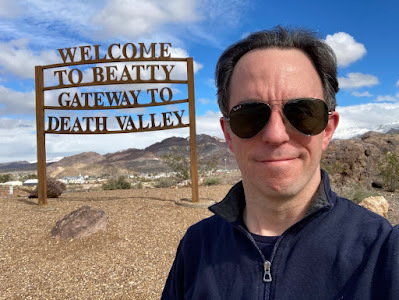
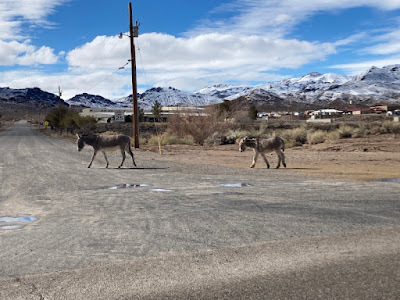 Wild donkeys roam Beatty, a town close to Rhyolite.
Wild donkeys roam Beatty, a town close to Rhyolite.
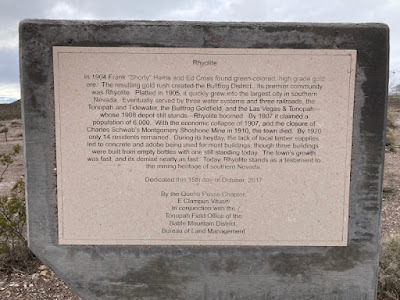 One Rhyolite welcome sign.The town thrived only from 1905 to 1910.
One Rhyolite welcome sign.The town thrived only from 1905 to 1910.
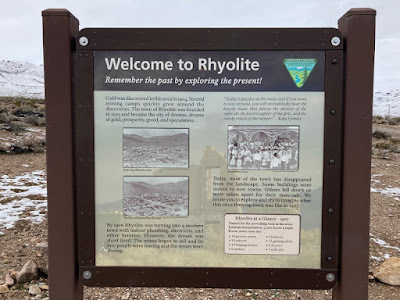 Another. (Eighteen grocery stores?)
Another. (Eighteen grocery stores?)
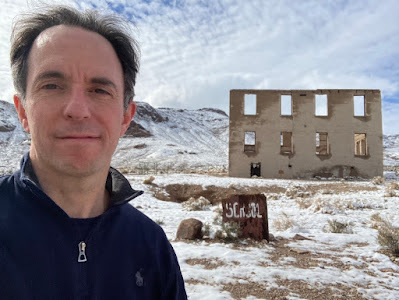 the school
the school
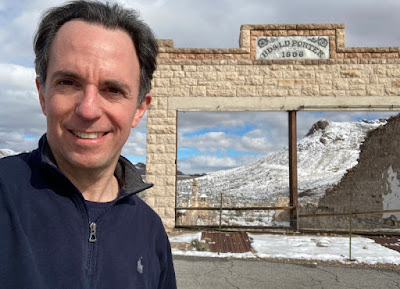 a shop
a shop
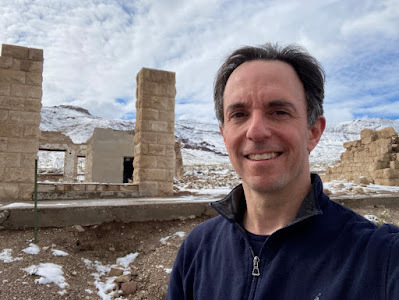
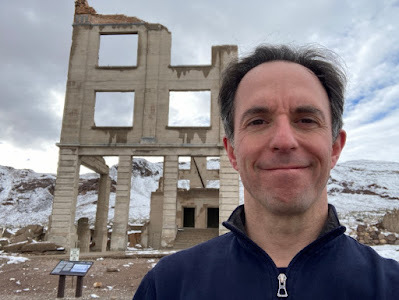
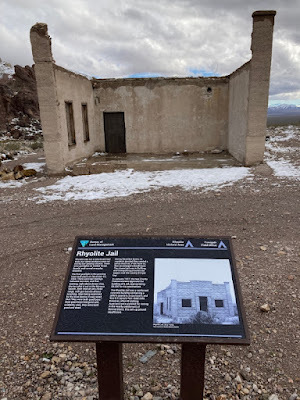 the jail
the jail
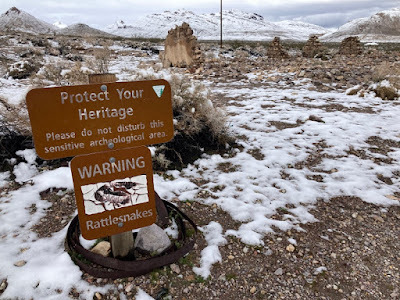 No rattlesnakes in February.
No rattlesnakes in February.
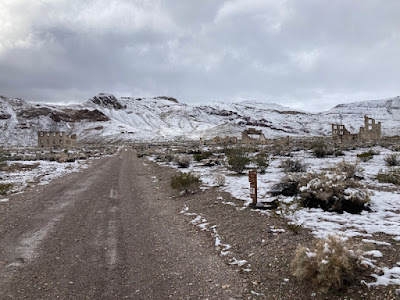
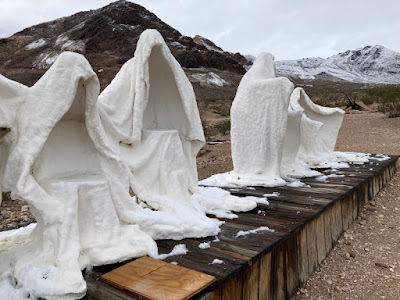 Just outside Rhyolite is the Goldwell Open Air Museum.This sculpture fits perfectly with the ghost motif.
Just outside Rhyolite is the Goldwell Open Air Museum.This sculpture fits perfectly with the ghost motif.
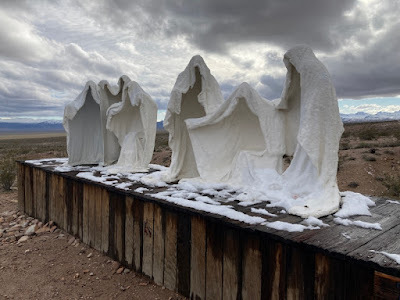
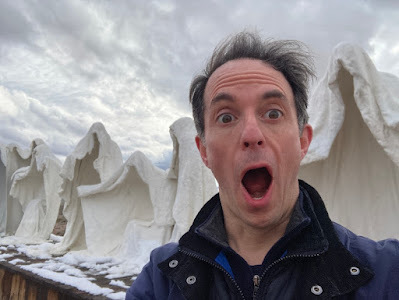
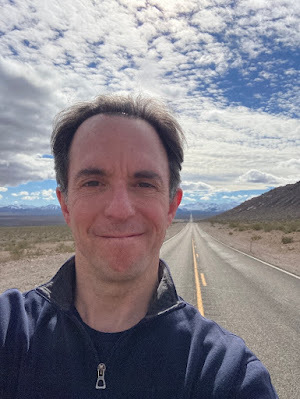 So many opportunities to safely take a selfieon a straight road that stretches to thevanishing point.
So many opportunities to safely take a selfieon a straight road that stretches to thevanishing point.
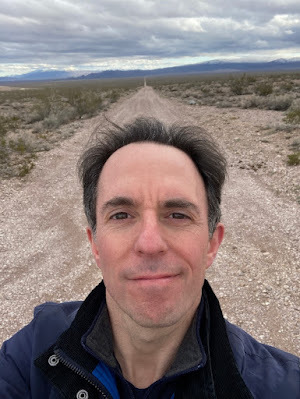
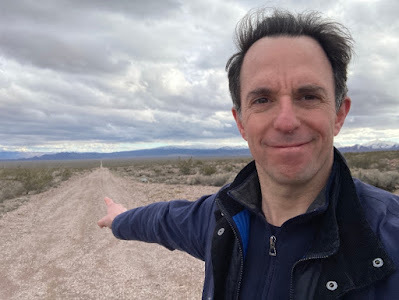

But first I went ghost hunting.
I've been to Vegas numerous other times, and I've ventured to the desert before, once to drive an ATV (loved) and once to drive a dune buggy (hated). But this was the first time I drove myself out of the city—two hours into the breathtaking landscape to see Rhyolite, which some consider the best ghost town in Nevada. Adding to the eerieness, it's on the edge of Death Valley.
(The only other ghost town I've visited is a much smaller one in the woods in Maryland.)

 Wild donkeys roam Beatty, a town close to Rhyolite.
Wild donkeys roam Beatty, a town close to Rhyolite. One Rhyolite welcome sign.The town thrived only from 1905 to 1910.
One Rhyolite welcome sign.The town thrived only from 1905 to 1910. Another. (Eighteen grocery stores?)
Another. (Eighteen grocery stores?) the school
the school a shop
a shop

 the jail
the jail No rattlesnakes in February.
No rattlesnakes in February.
 Just outside Rhyolite is the Goldwell Open Air Museum.This sculpture fits perfectly with the ghost motif.
Just outside Rhyolite is the Goldwell Open Air Museum.This sculpture fits perfectly with the ghost motif.

 So many opportunities to safely take a selfieon a straight road that stretches to thevanishing point.
So many opportunities to safely take a selfieon a straight road that stretches to thevanishing point.


Published on March 02, 2023 07:00
February 28, 2023
First school visits in London
On 2/17/23, I arrived in London for my first school visits in the United Kingdom. But my initial catalyst to make the weeklong trip was not those speaking engagements. For what was, see the end of this post.
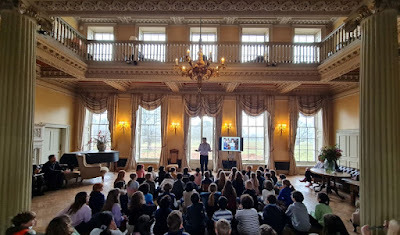 Hampton Court House(one of the three schools I spoke at; it's housed in a handsome structure built in 1757)
Hampton Court House(one of the three schools I spoke at; it's housed in a handsome structure built in 1757)
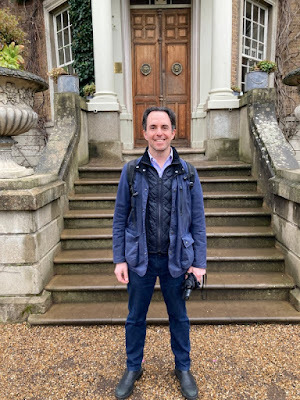 exterior of HCH
exterior of HCH
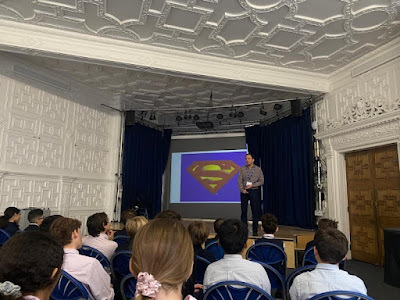 Knightsbridge School
Knightsbridge School
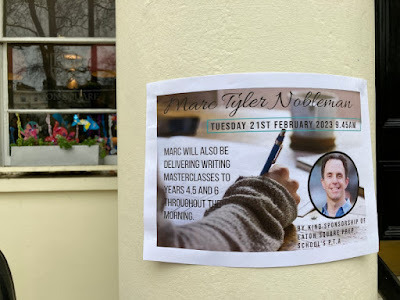 Eaton Square Prep School
Eaton Square Prep School
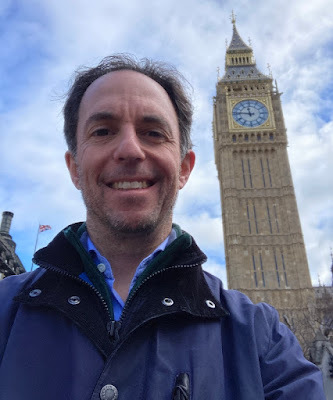 Big Ben(not a school)
Big Ben(not a school)
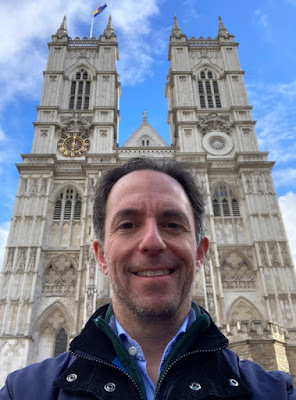 Westminster Abbey
Westminster Abbey
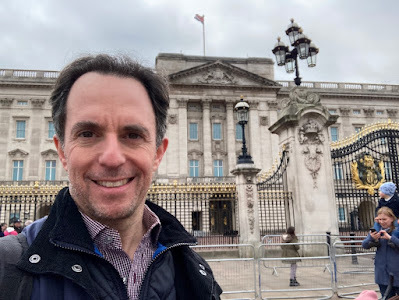 Buckingham Palace
Buckingham Palace
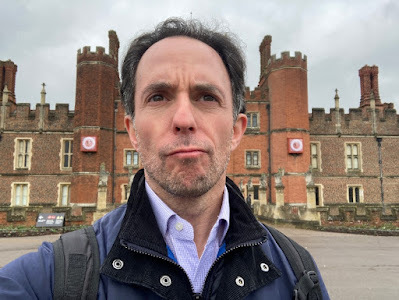 Hampton Court Palace,onetime home of Henry VIII and his VI wives
Hampton Court Palace,onetime home of Henry VIII and his VI wives
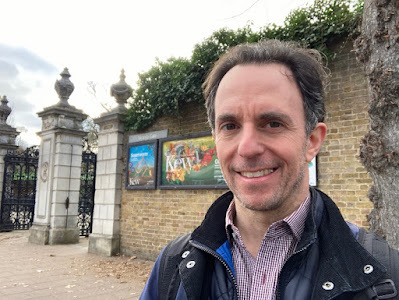 Kew Gardens
Kew Gardens
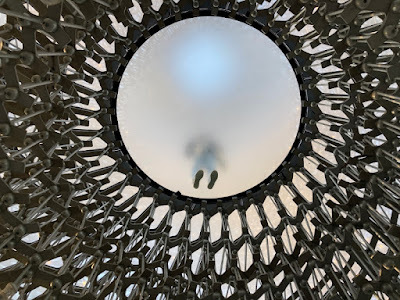 The Hive, a striking installation in Kew Gardens
The Hive, a striking installation in Kew Gardens
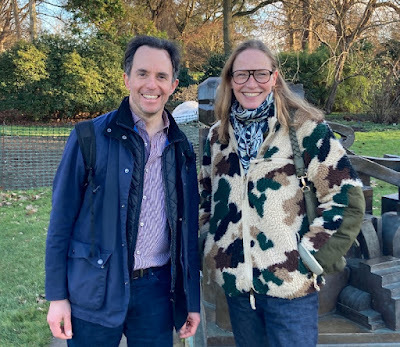 A decade ago I found and interviewed the five women who appeared in the iconic video for "Addicted to Love" by Robert Palmer. On this trip, I met three of them in person. Mak Gilchrist gave me an articulate and fascinating tour of Kew Gardens.
A decade ago I found and interviewed the five women who appeared in the iconic video for "Addicted to Love" by Robert Palmer. On this trip, I met three of them in person. Mak Gilchrist gave me an articulate and fascinating tour of Kew Gardens.
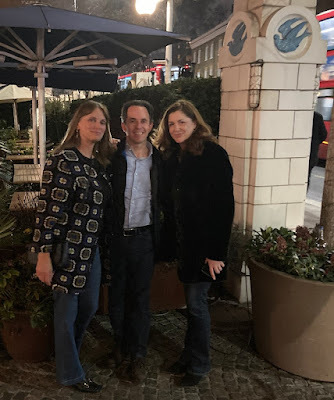 Julie Pankhurst and Julia Bolino took me to apopular meeting spot with character in spades.
Julie Pankhurst and Julia Bolino took me to apopular meeting spot with character in spades.
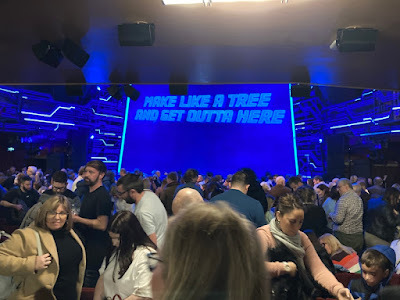 I saw the musical inspired by Back to the Future.I thought this was the funniest part.
I saw the musical inspired by Back to the Future.I thought this was the funniest part.
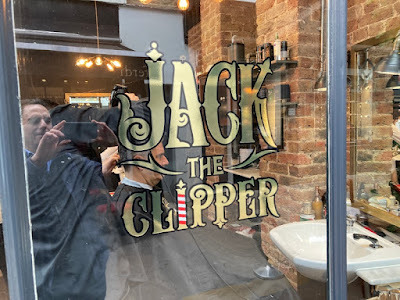 speaking of funny (because tragedy plus time equals...)
speaking of funny (because tragedy plus time equals...)
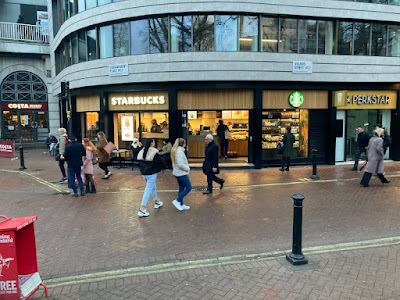 again speaking of funny: three coffee shops in a row
again speaking of funny: three coffee shops in a row
 I walked a lot in London.
I walked a lot in London.
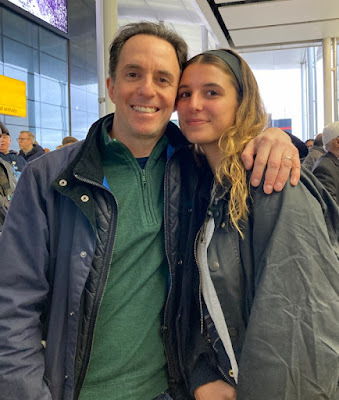 The reason I planned the trip...my daughter would be in town,returning from a five-week gap year service trip in Kenya.I surprised her. At the airport at 6:30 am.
The reason I planned the trip...my daughter would be in town,returning from a five-week gap year service trip in Kenya.I surprised her. At the airport at 6:30 am.
 Hampton Court House(one of the three schools I spoke at; it's housed in a handsome structure built in 1757)
Hampton Court House(one of the three schools I spoke at; it's housed in a handsome structure built in 1757) exterior of HCH
exterior of HCH Knightsbridge School
Knightsbridge School Eaton Square Prep School
Eaton Square Prep School Big Ben(not a school)
Big Ben(not a school) Westminster Abbey
Westminster Abbey Buckingham Palace
Buckingham Palace Hampton Court Palace,onetime home of Henry VIII and his VI wives
Hampton Court Palace,onetime home of Henry VIII and his VI wives Kew Gardens
Kew Gardens The Hive, a striking installation in Kew Gardens
The Hive, a striking installation in Kew Gardens A decade ago I found and interviewed the five women who appeared in the iconic video for "Addicted to Love" by Robert Palmer. On this trip, I met three of them in person. Mak Gilchrist gave me an articulate and fascinating tour of Kew Gardens.
A decade ago I found and interviewed the five women who appeared in the iconic video for "Addicted to Love" by Robert Palmer. On this trip, I met three of them in person. Mak Gilchrist gave me an articulate and fascinating tour of Kew Gardens. Julie Pankhurst and Julia Bolino took me to apopular meeting spot with character in spades.
Julie Pankhurst and Julia Bolino took me to apopular meeting spot with character in spades. I saw the musical inspired by Back to the Future.I thought this was the funniest part.
I saw the musical inspired by Back to the Future.I thought this was the funniest part. speaking of funny (because tragedy plus time equals...)
speaking of funny (because tragedy plus time equals...) again speaking of funny: three coffee shops in a row
again speaking of funny: three coffee shops in a row I walked a lot in London.
I walked a lot in London. The reason I planned the trip...my daughter would be in town,returning from a five-week gap year service trip in Kenya.I surprised her. At the airport at 6:30 am.
The reason I planned the trip...my daughter would be in town,returning from a five-week gap year service trip in Kenya.I surprised her. At the airport at 6:30 am.
Published on February 28, 2023 20:37
February 20, 2023
Meeting the "Addicted to Love" video women
Ten years ago, I had the thrill and privilege of being the first person to find and interview all five women from the iconic video for Robert Palmer's "Addicted to Love" (1986).
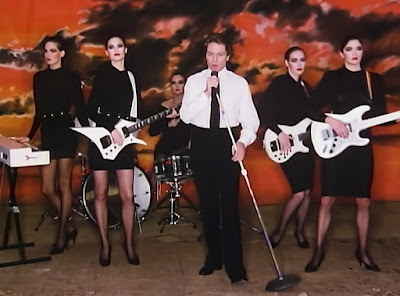
A year later, the fab five reunited in person for the first time since the shoot.
Lovely people all, and we've stayed in touch. Patty Elias lives in California, Kathy Davies lives in Thailand, and the other three are still in London (where the video was shot).
On 2/17/23, at Bluebird in London, I had the thrill and privilege to meet two of them in person, Julie Pankhurst (keyboards) and Julia Bolino (guitar far right).
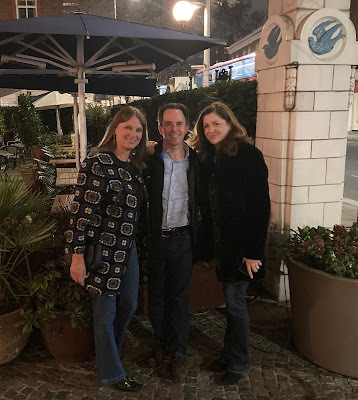 Julie again on left, Julia again on right.A wee bit blurry but best we got. Gonna have to face it.
Julie again on left, Julia again on right.A wee bit blurry but best we got. Gonna have to face it.
Three days later, still in London, I met a third, Mak Gilchrist, who had been out of town the night I met Julie and Julia. She took me on an enlightening walking tour of Kew Gardens, where I'd never been.
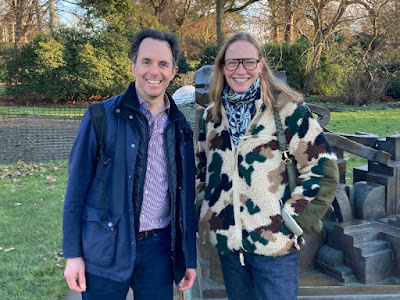
It was mind-warping to get to know people I'd known of since I was 14 and now consider friends.
Everyone has a story behind the story...

A year later, the fab five reunited in person for the first time since the shoot.
Lovely people all, and we've stayed in touch. Patty Elias lives in California, Kathy Davies lives in Thailand, and the other three are still in London (where the video was shot).
On 2/17/23, at Bluebird in London, I had the thrill and privilege to meet two of them in person, Julie Pankhurst (keyboards) and Julia Bolino (guitar far right).
 Julie again on left, Julia again on right.A wee bit blurry but best we got. Gonna have to face it.
Julie again on left, Julia again on right.A wee bit blurry but best we got. Gonna have to face it.Three days later, still in London, I met a third, Mak Gilchrist, who had been out of town the night I met Julie and Julia. She took me on an enlightening walking tour of Kew Gardens, where I'd never been.

It was mind-warping to get to know people I'd known of since I was 14 and now consider friends.
Everyone has a story behind the story...
Published on February 20, 2023 14:30



